This page contains affiliate links. Please read our disclosure for more info.
Kyoto is a magical city like nowhere else. As the imperial capital of Japan for over 1000 years (until 1868), it’s the heart of traditional Japanese culture.
There are so many incredible things to do in Kyoto—you can visit golden temples and vermillion shrines, stroll through Zen rock gardens and swaying bamboo forests, slurp down bowls of ramen and participate in graceful tea ceremonies.
It’s one of the only places you can still glimpse geisha in extravagant kimono and white makeup rushing to appointments in wooden teahouses.
Monks still live and work in the city’s 2000 temples and shrines—you’ll see them in flowing robes performing ceremonies and hear the chanting.
You’ll visit a lot of temples in Kyoto, but even after spending three months in the city, we never tire of them. They all offer something unique—a shimmering pavilion, peaceful garden, forest hike, or a delicious vegetarian meal.
Although Kyoto is the centre of traditional Japan, it’s also a modern city with concrete high-rises, numerous vending machines, and a vibrant food scene.
But it’s on a smaller, more manageable scale than Tokyo or Osaka with plenty of green spaces, views of the surrounding hills, and neighbourhoods that feel like villages.
Despite the numerous attractions (including 17 UNESCO World Heritage Sites), Kyoto is best explored at a slower pace with time for aimless wandering down narrow stone streets.
In this Kyoto travel guide, I share all the best things to do in Kyoto as well as tips on avoiding the crowds and how to get around. You’ll find a map with all these top Kyoto attractions at the end of the post.
Contents
- How to Avoid the Crowds in Kyoto
- Top Things to Do in Kyoto
- Quieter Temples to Visit in Kyoto
- Foodie Things to Do in Kyoto
- Kyoto Activities in Nature
- Cultural Things to Do in Kyoto
- Kyoto Attractions Map
- How to Get to Kyoto
- Video: What to Do in Kyoto
- Is Kyoto Worth Visiting?
- More Japan Posts
How to Avoid the Crowds in Kyoto
In 2011, when we first visited Kyoto, Japan received 6.2 million overseas visitors. In 2023, 25 million tourists visited the country.
That’s a huge increase, and as Kyoto is one of the most popular tourist destinations in Japan, we did notice a startling rise in crowd sizes on our recent visits.
Here are some tips to enjoy Kyoto despite the crowds:
1) Visit for as long as possible
Kyoto deserves more than the two days many people allocate it.
I recommend spending at least four full days here, but a week is ideal and allows time for some of these Kyoto day trips (Nara is the most popular).
We’ve spent three months in the city and still haven’t seen it all.
A longer stay will give you more time to explore less well-known Kyoto attractions and visit popular places at off-peak times.
2) Stay close to major sights
In order to do the next tip, it will help if you are staying close to the popular Kyoto tourist attractions.
You’ll be able to set out early in the morning, take a break in the busy afternoons, and head out again in the evenings without having to travel too far.
I think the best area to stay is Southern Higashiyama (including Gion) at the foot of Kyoto’s eastern hills.
There are a multitude of temples to explore as well as the most beautiful preserved streets and the chance to spot geisha.
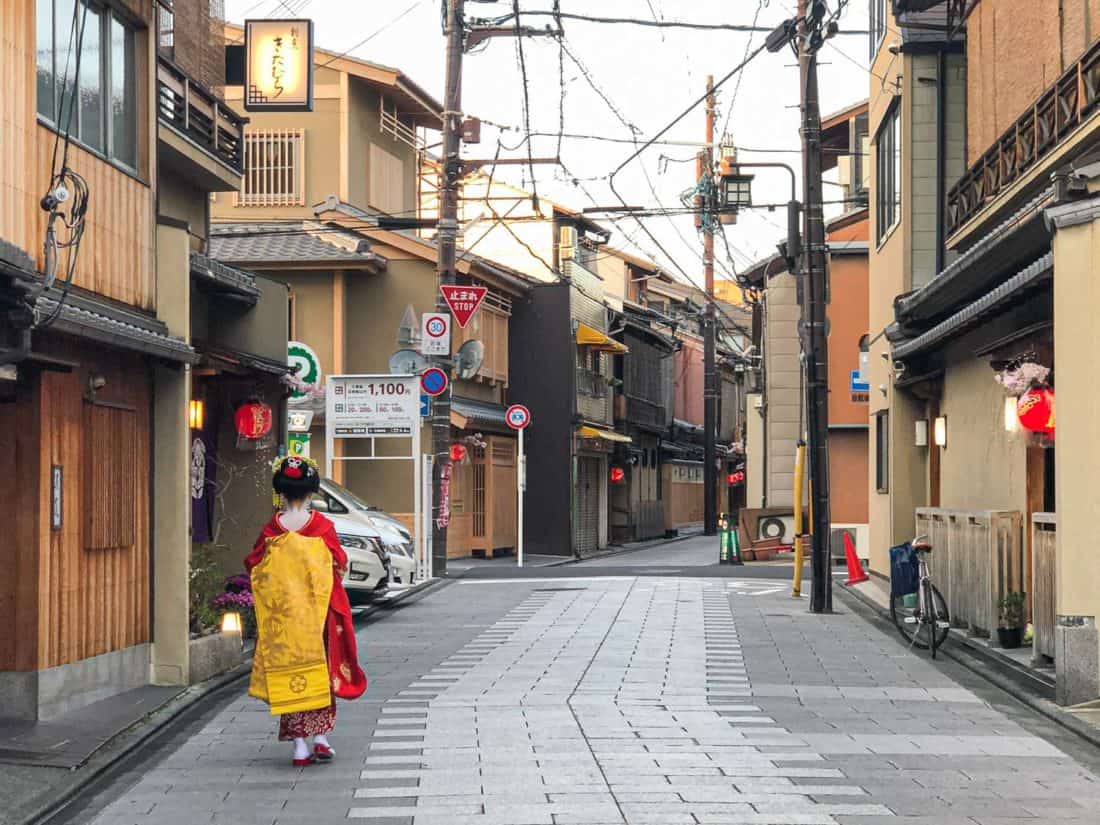
We enjoyed our stay at Hotel The Celestine Kyoto Gion on a quiet street in Gion. It has stylish, modern rooms and an onsite onsen and tempura restaurant.
If you’d like to stay in a ryokan (traditional inn), the Japanese-style suites at Ryokan Yachiyo are beautiful (and huge!) with private open-air baths and garden views. It’s a little further from Gion but close to Nanzen-ji temple and the famous Philosopher’s Path.
We also loved our stay at Sora Niwa Terrace, which has incredible views from its roof terrace and onsen. It’s just over the river from Gion in downtown Kyoto (ideal for shopping).
See my guide to where to stay in Kyoto for more recommended hotels and neighbourhood information.
3) Get up early
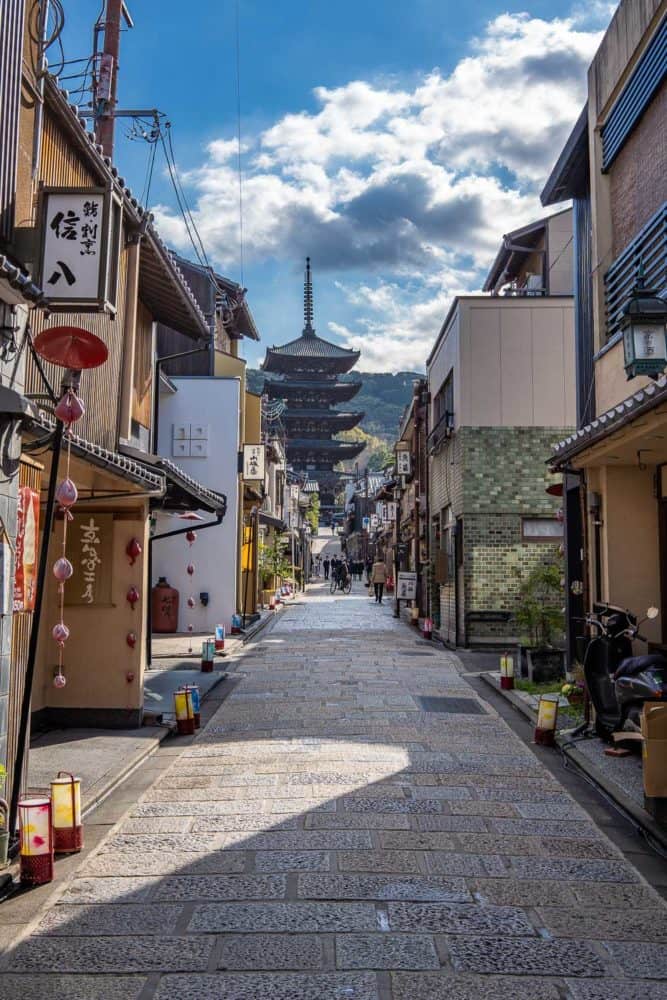
Visiting the most popular sights early in the morning is essential to truly enjoy them. It’s so much harder to appreciate the magic when you’re battling through tour groups.
These are the places that are most important to visit early (on weekdays if possible). If you can’t manage to make it early, then try an hour before closing.
- Fushimi Inari shrine – It’s open 24 hours so go around sunrise (6 am is best) or as late at night as possible (after 8 pm). It’s our favourite place in the city (and one of the most unique things to do in Kyoto), but we gave up after 10 minutes when we visited one afternoon as the crowds were intense.
- Kiyomizu-dera Temple – It opens at 6 am and this is the best time to visit (or definitely before 8 am). The picturesque streets leading up to it are also best enjoyed early (or late).
- Kinkaku-ji Temple (Golden Pavilion) – It’s open from 9 am – 5 pm so either arrive in time for opening or at 4 pm, but it’s hard to escape the crowds.
- Ginkaku-ji Temple (Silver Pavilion) – Arrive at opening at 8.30 am or at 4 pm (before it closes at 5 pm).
- Nishiki Market – It’s not as essential to arrive early, but lunchtime here is packed. 10 am is better or just before closing around 5 pm.
I could also add the Arashiyama bamboo grove to this list as it’s one of the most popular Kyoto tourist spots and gets horribly crowded (even before 9 am).
Honestly, I think it’s overrated and haven’t included it in my things to do in Kyoto list. I suggest some quieter, more enjoyable bamboo groves below.
If you have limited time in Kyoto and prefer exploring with a guide, this popular Kyoto early bird tour avoids the crowds at Fushimi Inari, Kinkaku-ji (Golden Pavilion), and the bamboo grove by starting before 7 am.
4) Discover quieter temples and shrines
It’s easy to find quiet temples and shrines in Kyoto—they are often just around the corner from the crowded spots that everyone feels they have to see.
I highly recommend including some hidden gems along with popular attractions. Perhaps start your day early at one of the temples above and then head to some quieter alternatives.
5) Take a break from temples
Although the temples are incredible, save your energy by mixing them up with some fun and unusual activities.
Take a cooking class, stroll along a quiet canal, sip matcha in a tearoom (or make your own during a tea ceremony), learn samurai skills, or hike through a forest—you’ll find plenty of ideas of what to do in Kyoto below.
Top Things to Do in Kyoto
These are the most popular things to do in Kyoto and they do get crowded.
1) Hike Through Torii Gates at Fushimi Inari Shrine
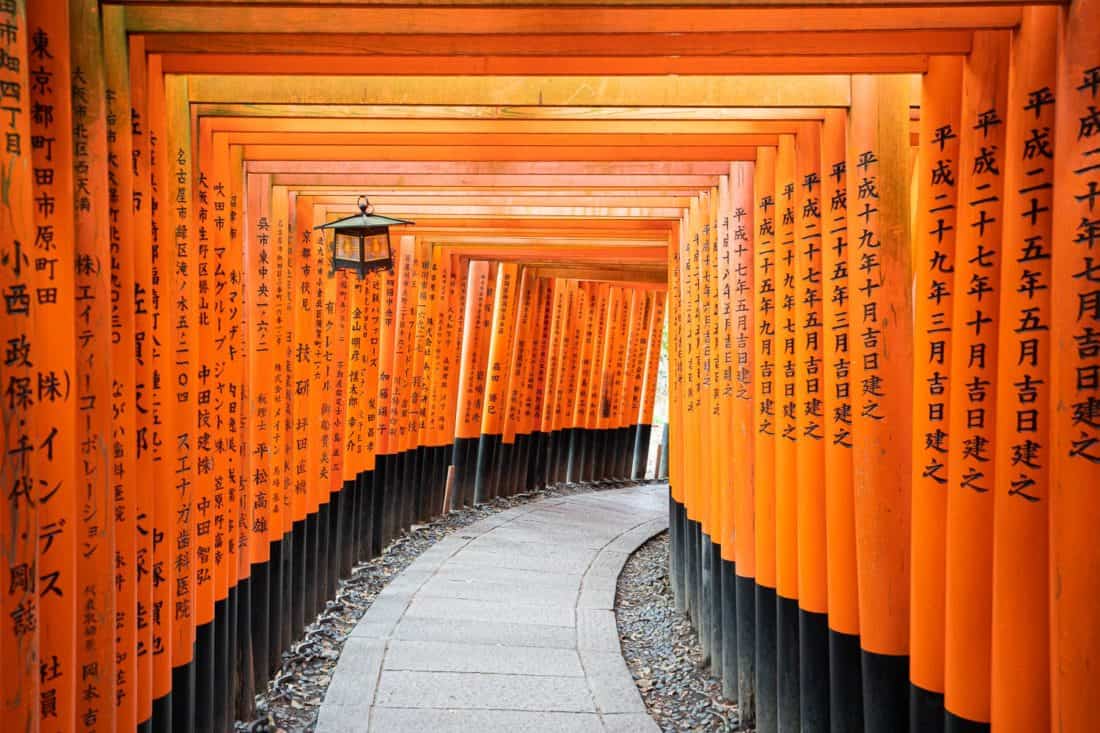
Fushimi Inari is a Kyoto must see. We’ve never visited anywhere else like it—thousands of bright orange torii gates snake up through the forest into the mountains.
It’s as much of a hike as a temple visit (and quite steep in parts), although you do pass many small shrines with stone fox statues and miniature toriis.
The fox is considered the messenger of Inari, the Shinto god of rice.
It takes us about an hour and a half to complete the whole walk (a 5 km/ 3.1 mile loop from the station—see the AllTrails map), but you could easily spend two or three hours here.
You could also choose just to do the lower loop to a viewpoint over the city. I recommend continuing up the mountain as it gets much quieter and feels very peaceful as you walk through the deep forest.
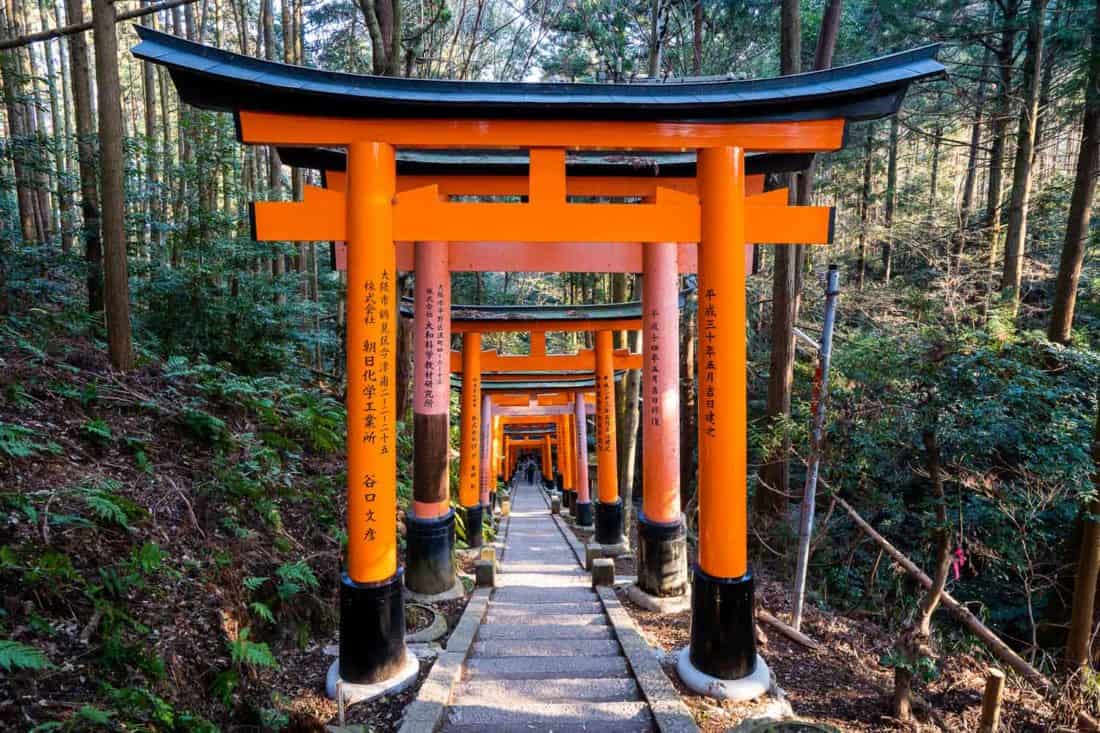
Fushimi Inari gets insanely busy and it’s no fun when you are walking with a crowd, so try to visit around 6 am (7 am at the latest) or after 8 pm.
It’s a very different experience at night with atmospheric lighting and a slightly spooky feel (we even heard a wild boar!).
Details: Free entry and open 24 hours. Take the train to Fushimi Inari Station on the Keihan Main Line (if coming from Higashiyama, 10 minutes from Gion-Shijo) or JR Inari Station on the JR Nara Line (if coming from Kyoto Station, 5 minutes).
2) Wander Around Gion and Southern Higashiyama
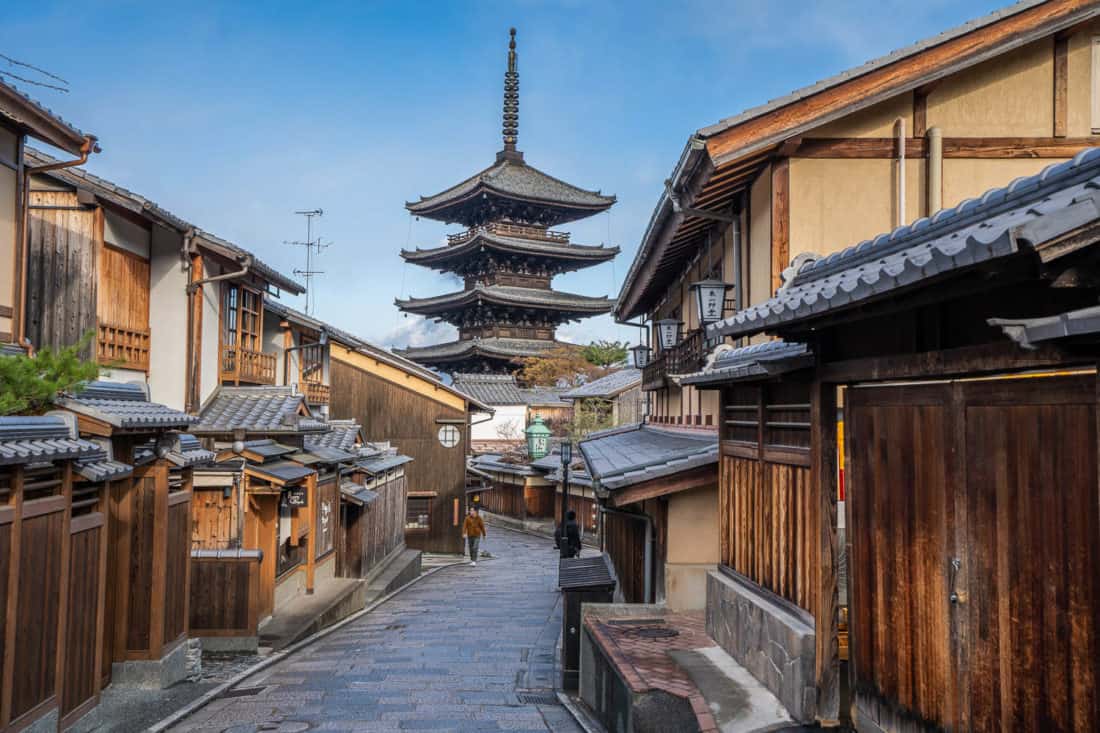
Southern Higashiyama, which includes Gion, is one of the top places to visit in Kyoto with some of the most picturesque and best-preserved streets in the city.
In this historic district you’ll find wooden houses on narrow lanes with paved stone pathways and paper lanterns lighting the way.
There are many temples to visit, but this area is perfect for aimless wandering (ideally early morning or late at night, which is why it’s one of the best areas to stay in Kyoto) and soaking up the charm.
Many visitors rent kimono for a day and explore in traditional Japanese attire.
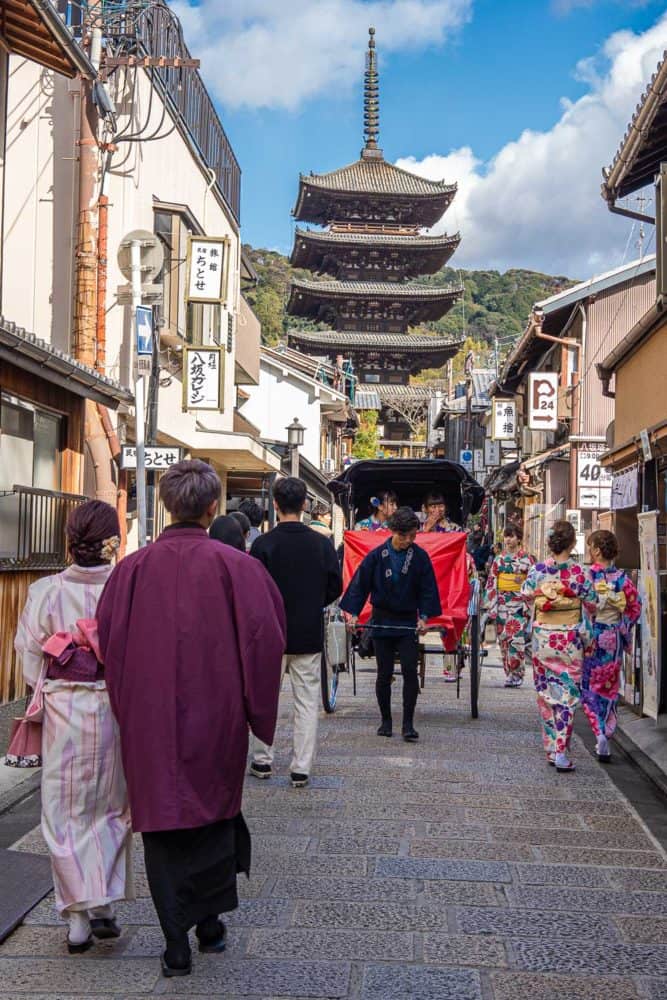
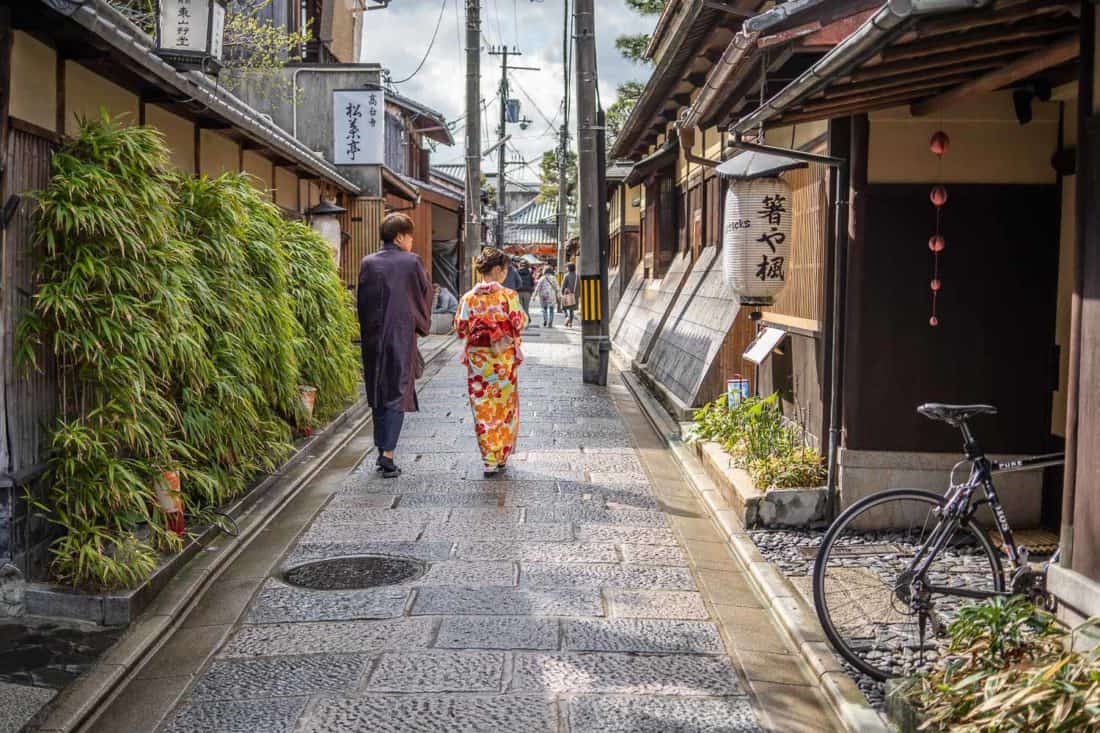
Streets not to miss include Yasaka-dori which leads to Yasaka Pagoda (Hōkanji Temple), Ninenzaka and Sannenzaka, Nene-no-michi, and Ishibei-koji lane.
Please respect any signs that say no photos are allowed.
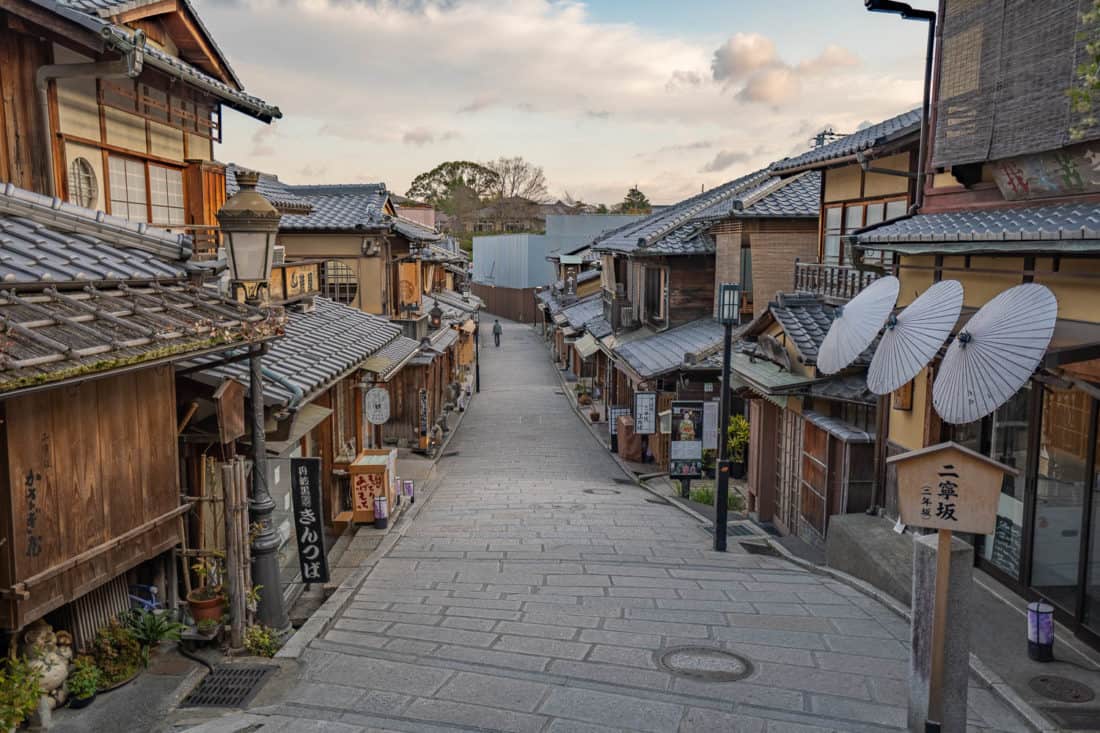
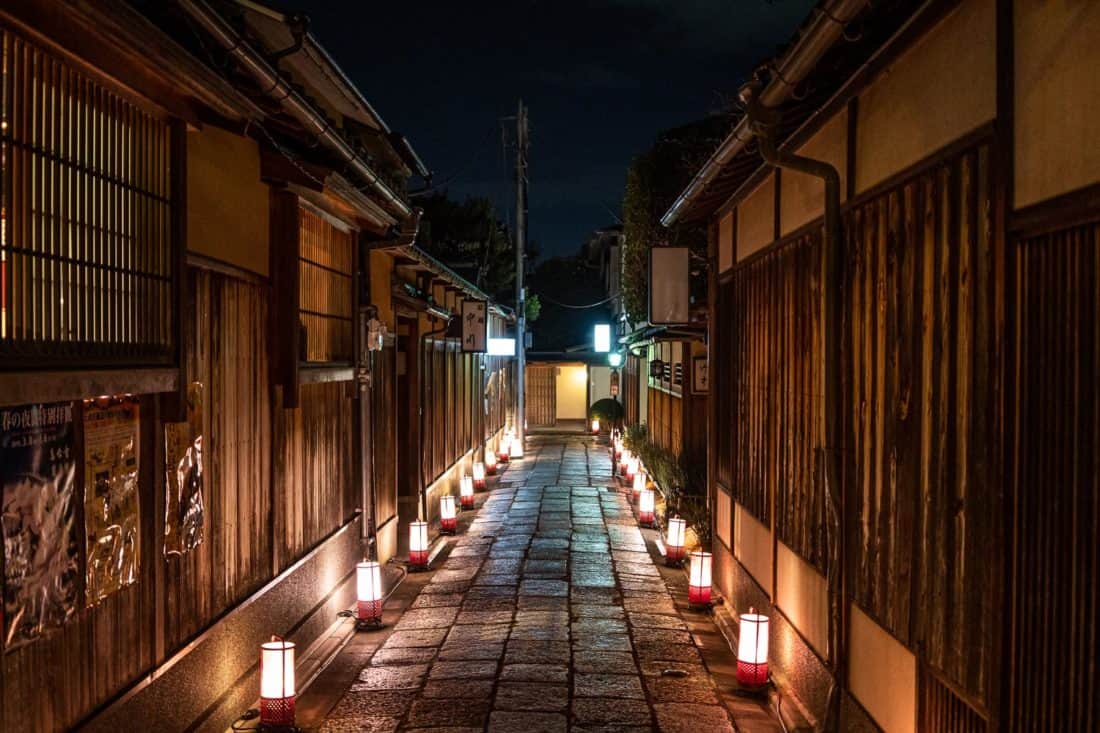
Gion, Kyoto’s main geisha district, is also lovely for strolling day and night. Don’t miss Hanami-koji, the Shirakawa Canal, Shinbashi-dori, and Yasaka Shrine (free entry).
On the traditional streets of Gion, you may spot a geisha rushing to an appointment at one of the teahouses (especially between 5.30 pm and 6 pm).
Yes, it’s exciting, but the hordes of tourists trying to take photos have made life unpleasant for them. Please keep your distance and be respectful.
We often saw geisha without mobs of tourists following them in the quieter Miyagawacho geisha district when we stayed near Miyagawacho Kaburenjo theatre.
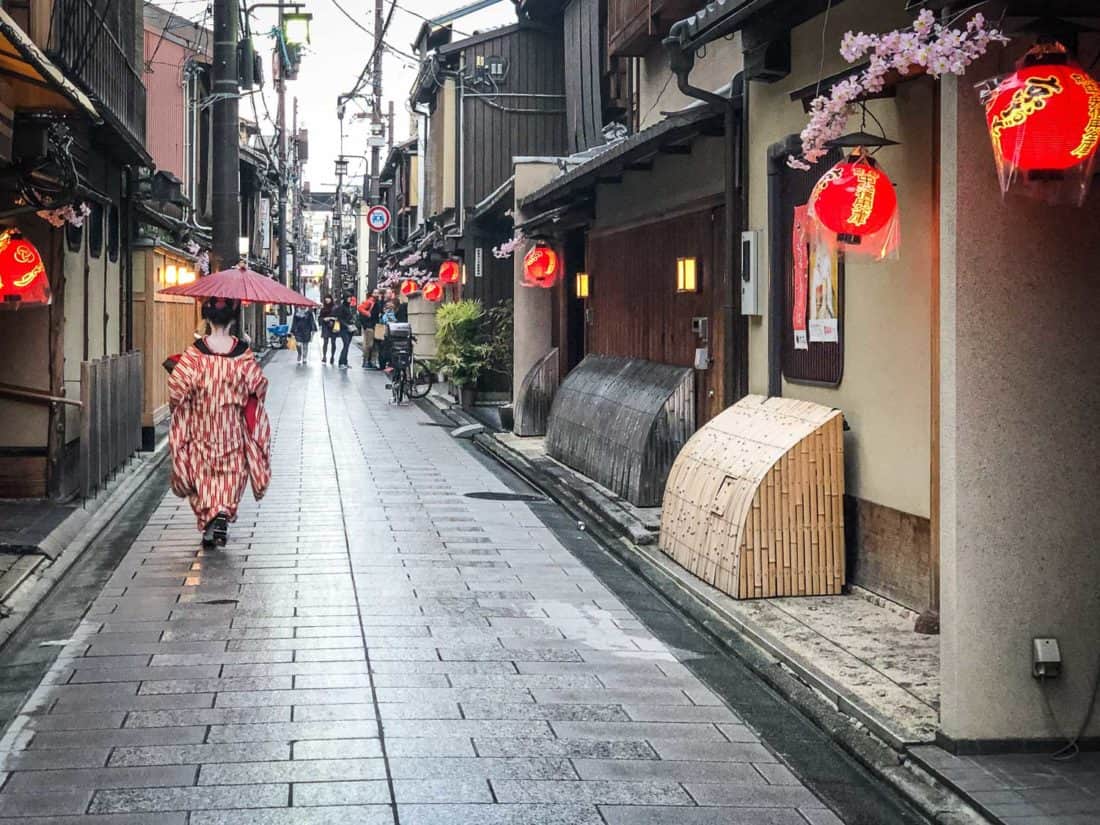
Wandering around Gion is one of the top things to do in Kyoto at night.
If you’d like to explore with a guide, this Gion at night group walking tour has excellent reviews and is a good way to learn about geisha culture.
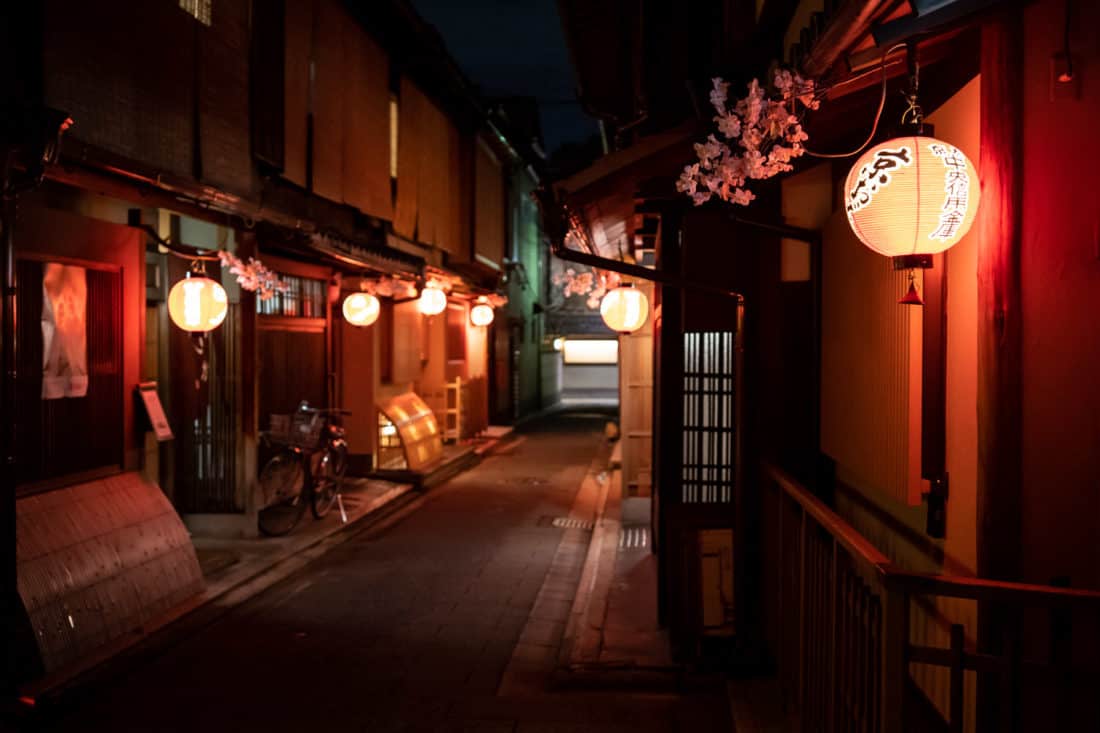
Details: Free to wander the streets. The nearest train stations are Gion-Shijo and Kiyomizu-Gojō on the Keihan Main Line. Or take the bus from Kyoto Station.
3) Enjoy the View from Kiyomizu-dera Temple
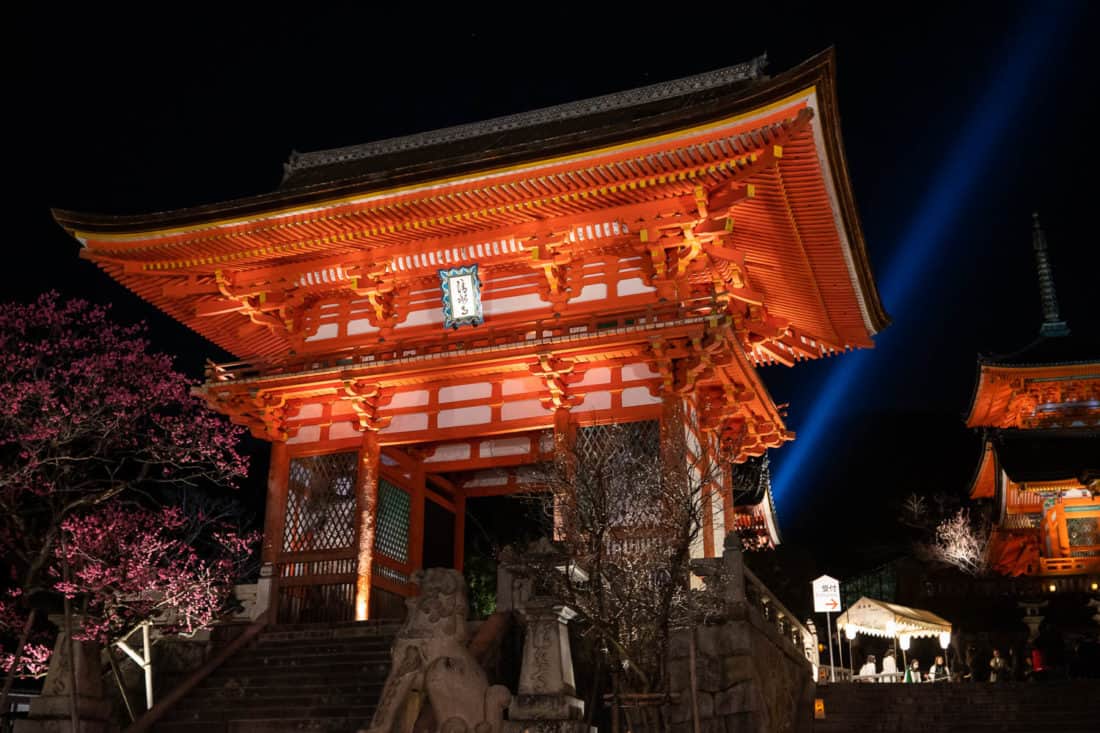
Another top Kyoto sightseeing spot, Kiyomizu-dera was founded in 778 AD and has a dramatic hillside location in Southern Higashiyama with views across the city.
The large wooden main hall was built without nails and houses a statue of the eleven-faced, thousand-armed Kannon.
It’s a large complex with many other buildings including an impressive entrance gate, red three-storey pagoda, quiet paths into the forest, and the bizarre Tainai-meguri where you enter into darkness to make a wish (one of the weirdest things to do in Kyoto).
Kiyomizu-dera opens earlier than other temples, and it’s well worth visiting at 6 am to avoid the tour groups. I especially appreciated my early morning visit when visiting Kyoto in autumn.
It can also be quieter during the night illuminations (when it’s open until 9.30 pm) in March and April. We found the November illuminations much busier.
Details: 400 yen ($3) entry fee. Open 6 am – 6 pm. It’s a 20-minute walk from Kiyomizu-Gojo Station on the Keihan Main Line. Walking up through the atmospheric lanes full of souvenir shops is part of the fun, but they get extremely busy in the middle of the day.
4) Stroll The Philosopher’s Path
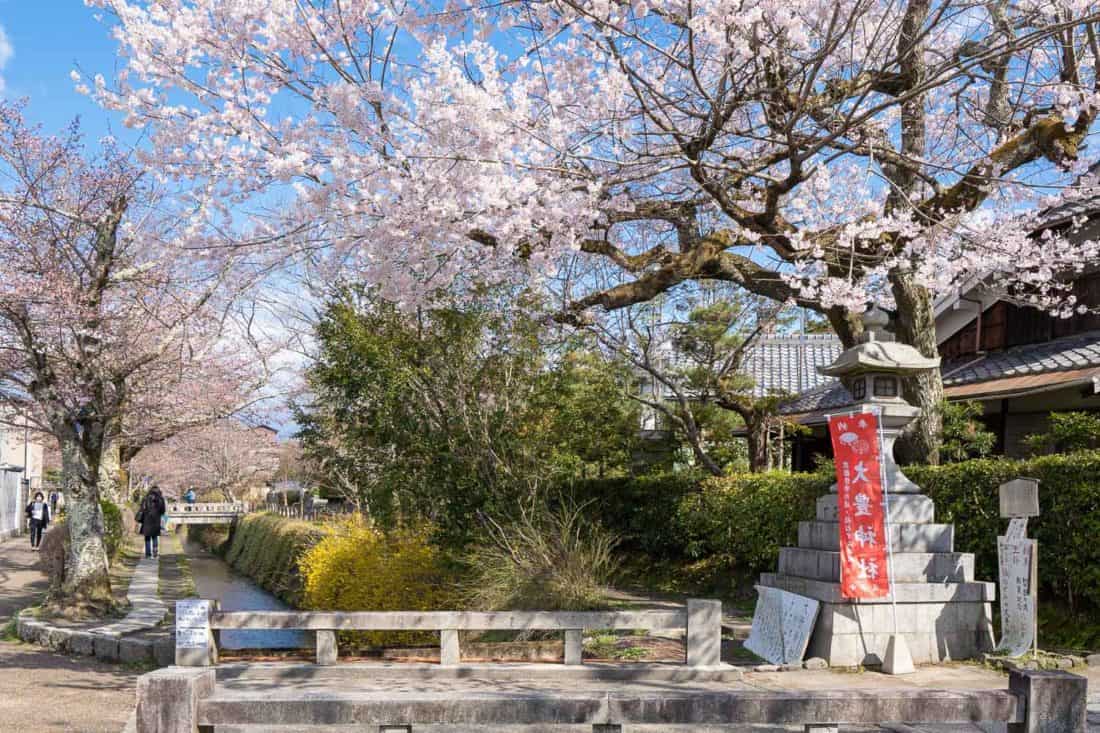
The Philosopher’s Path is a pedestrian walkway along a cherry-tree-lined canal in Northern Higashiyama.
It’s 2 km (1.2 miles) long and connects two of the most famous temples in Kyoto, Nanzen-ji and Ginkaku-ji.
It’s named because the Japanese philosopher Nishida Kitaro was said to have used it for his daily meditation.
The Philosopher’s Path is a pleasant place for a stroll and you can stop off at several quieter temples along the way including Honen-in.
In cherry blossom season, the path is a must do in Kyoto. We also found it pleasant (and much quieter) in autumn.
Details: Free to stroll the path. It’s not very near any train stations (Keage Station on the Tozai line is a 15-minute walk away).
We always walk here from Southern Higashiyama via Maruyama Park as there’s lots to see along the way. It’s about 5 km (3.1 miles) without detours from Yasaka Pagoda to the end of the Philosopher’s Path near Ginkaku-ji.
5) Explore Nanzen-ji Temple
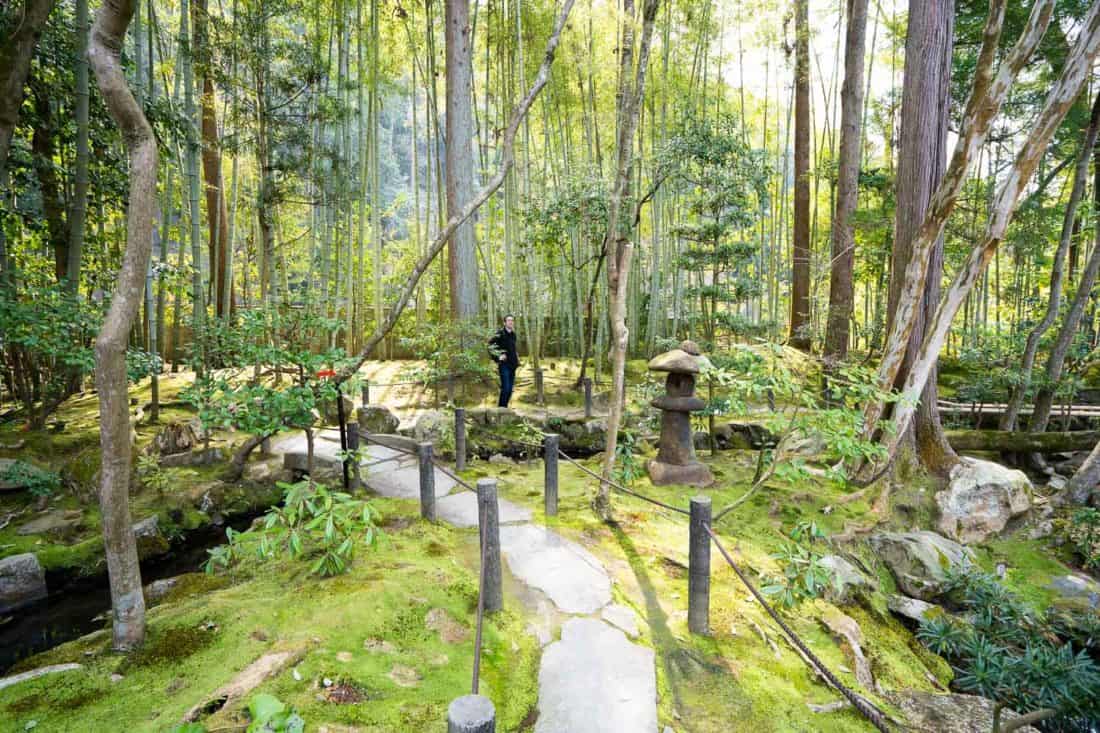
At one end of the Philosopher’s Path you’ll find Nanzen-ji, a large Zen temple complex that’s well worth a visit. It’s not usually too crowded and there’s plenty of space for everyone.
The shady grounds are free to wander and you can see the massive Sanmon entrance gate and a large brick aqueduct built during the Meiji period.
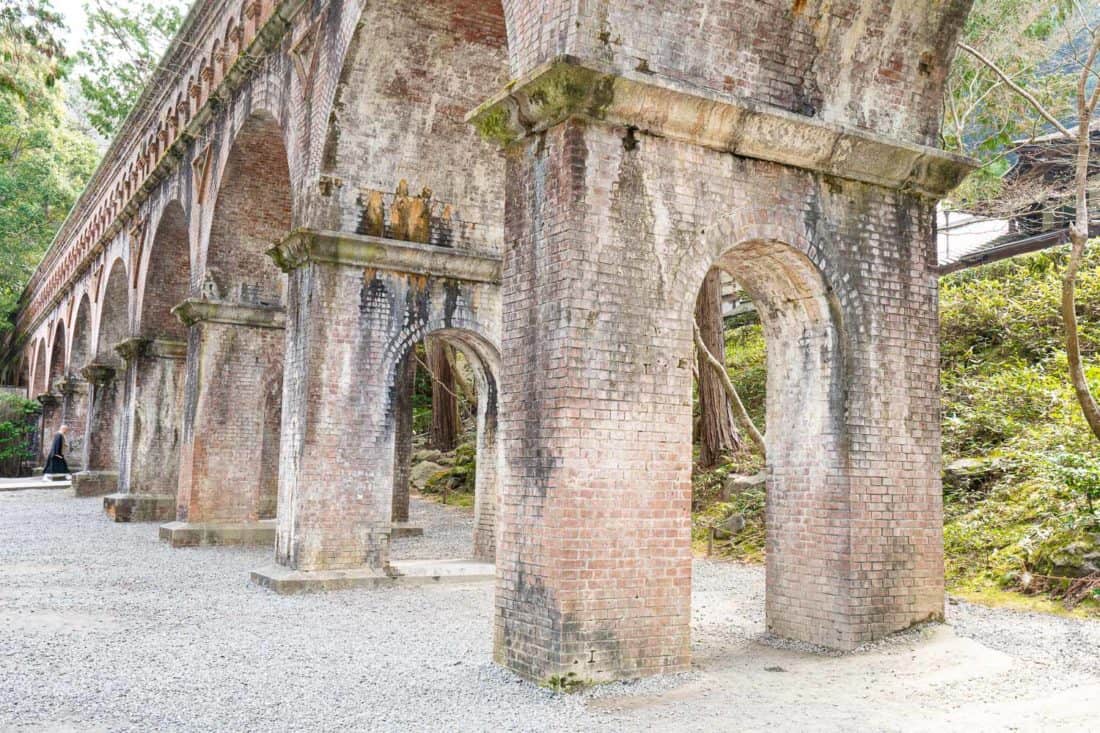
From here we like to head up the hill into the forest to the simple shrine Nanzen-ji Oku-no-in beside a small waterfall.
You can also pay to enter the sub-temples. We visited Tenjuan, which has two lovely gardens and is a peaceful escape from the crowds.
There’s a rock garden as well as a large pond garden featuring mossy rocks and a small bamboo grove. It’s especially beautiful in autumn leaf season.
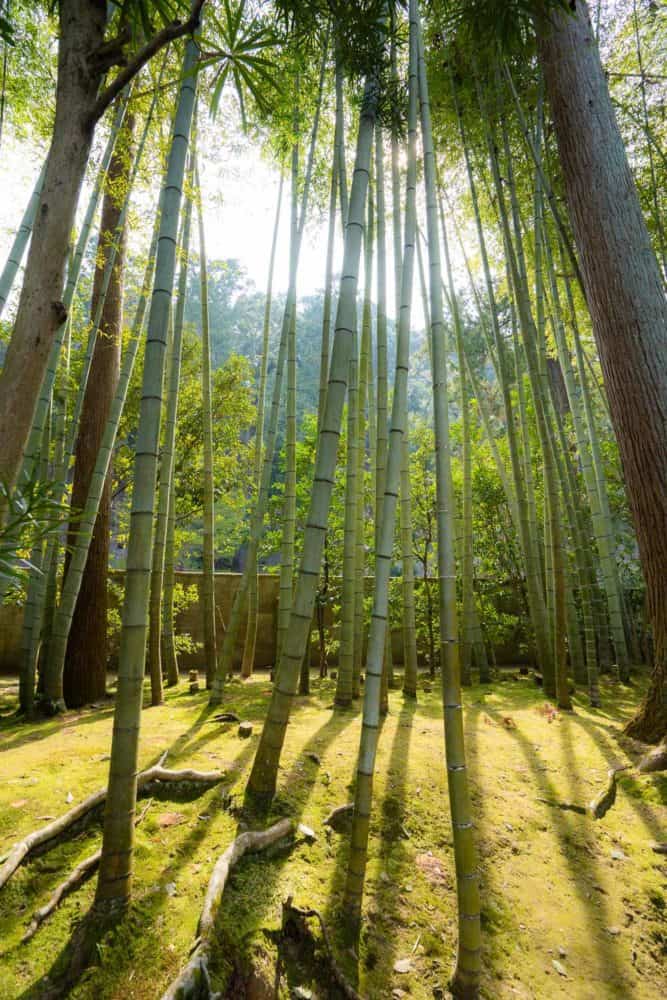
Details: Grounds are free. 500 yen ($3.50) to enter Tenjuan which is open 9 am – 4.45 pm. The nearest subway station is Keage Station on the Tozai line. We usually walk from Gion and continue along the Philosopher’s Path.
6) Visit the Ginkaku-ji Temple (Silver Pavilion)
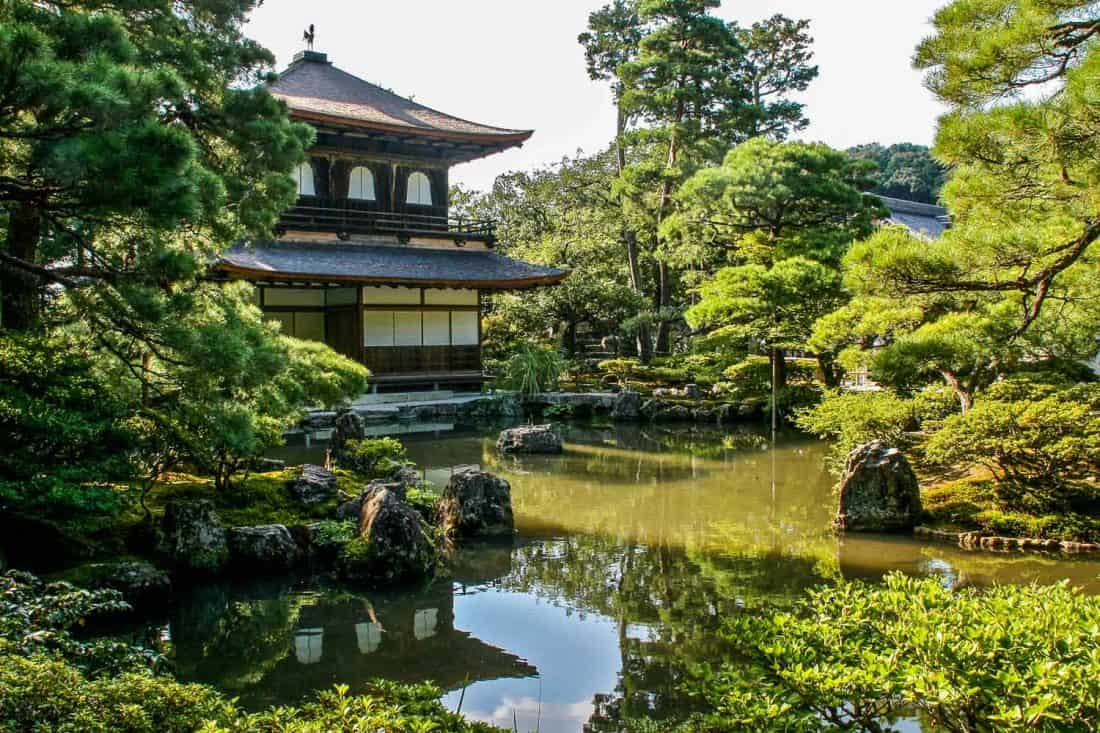
Ginkaku-ji means Silver Pavilion, but it was never covered in silver leaf. It’s one of Kyoto’s most popular temples and is located at the end of the Philosopher’s Path.
Even without the silver, it’s a lovely temple reflected in a pond.
The stunning gardens include an immaculately raked white sand Zen garden and a beautiful moss garden.
Make sure you follow the path up the hill to admire the temple from above.
Details: 500 yen ($3.50) entry fee. Open 8.30 am – 5 pm (9 am – 4.30 pm in winter). It’s best reached by walking the Philosopher’s Path or you can take bus 17 or 100 from Kyoto Station (40 minutes).
7) See the Golden Pavilion at Kinkaku-ji Temple
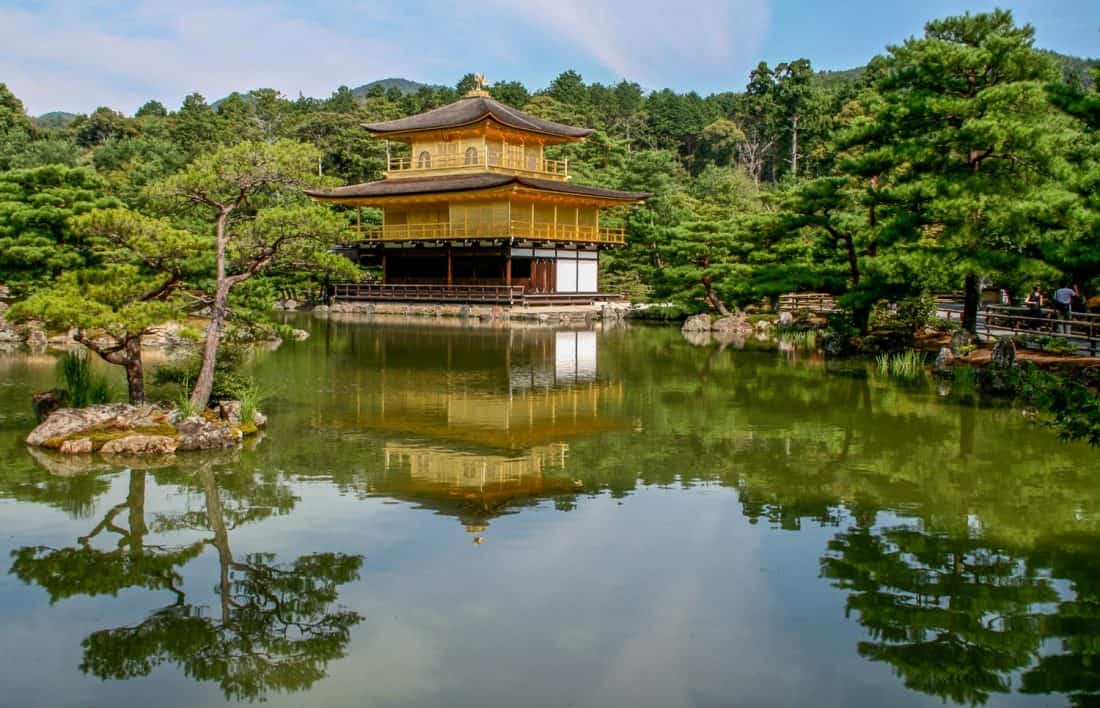
The Golden Temple or Kinkaku-ji is one of the most photographed sights in Kyoto.
We were prepared for the famous Zen temple to be overrated, and although it is almost always crowded, we couldn’t help but be impressed by the shimmering golden pavilion reflected in a pond dotted with islands of trees.
It was once the retirement villa of a shogun and it became a Zen temple after his death in 1408 (the building has been rebuilt after numerous fires since then).
The gardens are pleasant for a stroll (if not too busy) and it’s fun to get an English fortune from a vending machine.
Although it’s beautiful, it’s a bit out the way in northwest Kyoto, so if you only have one or two days in Kyoto, I would probably skip it.
Details: 500 yen ($3.50) entry fee. Open 9 am – 5 pm. There are no train stations nearby. You could cycle here (like we did), take a taxi, get the bus 101 or 205 from Kyoto Station (at least 40 minutes), or take a guided tour like the Kyoto early bird tour.
8) Spend a Day in Arashiyama
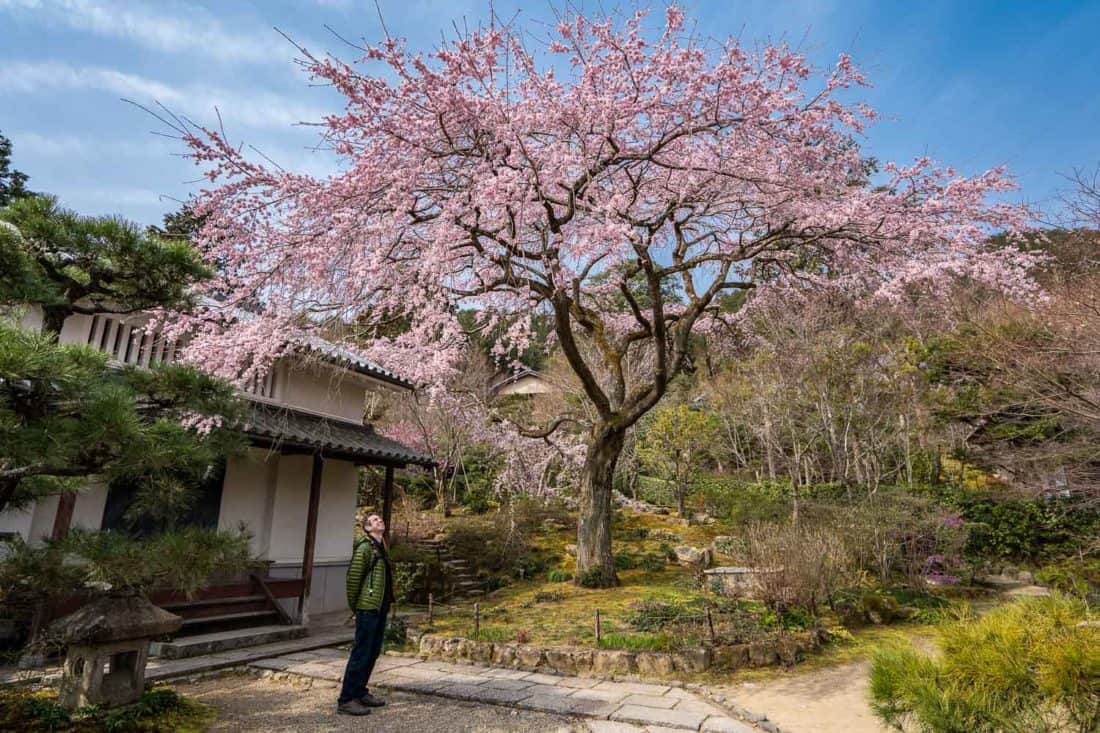
As I said above, I left out the Arashiyama bamboo grove from this list because the crowds have made it unenjoyable (see suggestions for quieter bamboo groves below).
That doesn’t mean you shouldn’t visit Arashiyama, though—we love this neighbourhood up in the western hills and recommend spending a day here. Away from the main sights it’s very peaceful.
Highlights include:
- Tenryu-ji – This Zen temple is the most popular attraction in the area and has beautiful gardens and delicious vegetarian lunches at the Shigetsu restaurant (see our Kyoto vegetarian guide). The bamboo grove is just outside if you want a quick walk through (just keep your expectations low).
- Okochi-Sanso Villa – The former home of famous film actor Okochi Denjiro features lovely strolling gardens and views of the city.
- Jojakko-ji – See below.
- Gio-ji – A tiny temple with a thatched-roof main hall overlooking a moss-covered grotto.
- Otagi Nenbutsu-ji – See below.
- Daikaku-ji – A grand temple complex and large pond with cherry trees.
Details: From Kyoto Station take the JR San-In line to Saga-Arashiyama Station (17 minutes) which is about a 10-minute walk from Tenryu-ji.
From Gion we walked to Kawaramachi station, took the train to Omiya then the Randen tram to Arashiyama, which took about an hour.
9) Seek out Cherry Blossoms or Autumn Leaves
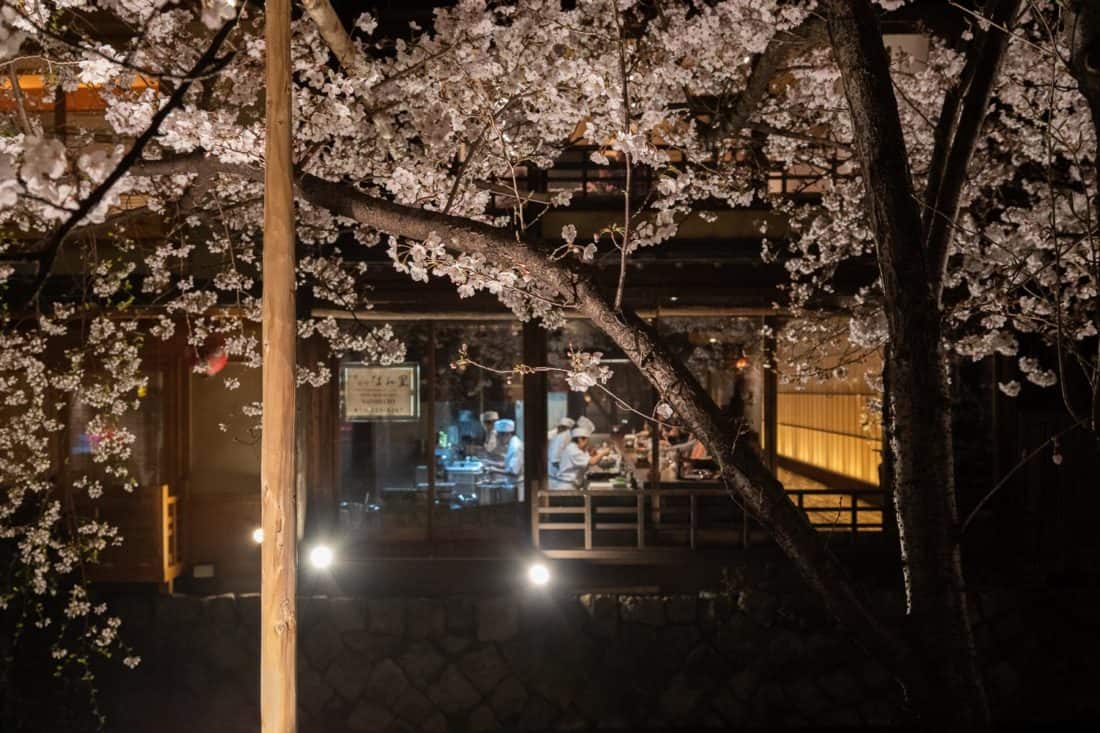
The beauty of Kyoto is that every season is different.
Winter is chilly and quiet; summer is hot, humid, lushly green, and festival-filled; but the most popular times to visit are spring or autumn.
In early April, the cherry blossoms (sakura) transform the city into a flowering wonderland.
While it’s crowded and expensive, it’s also magical and the festive atmosphere is fun. See our picks for the best places to see the Kyoto cherry blossoms.
Late November to early December is usually the best time to see colourful autumn leaves in Kyoto, which are just as beautiful as the blossoms.
Eikando Temple is our favourite place to see the fall colour, but there are many other fantastic spots. See our Kyoto in autumn guide for the best locations and forecast tips.
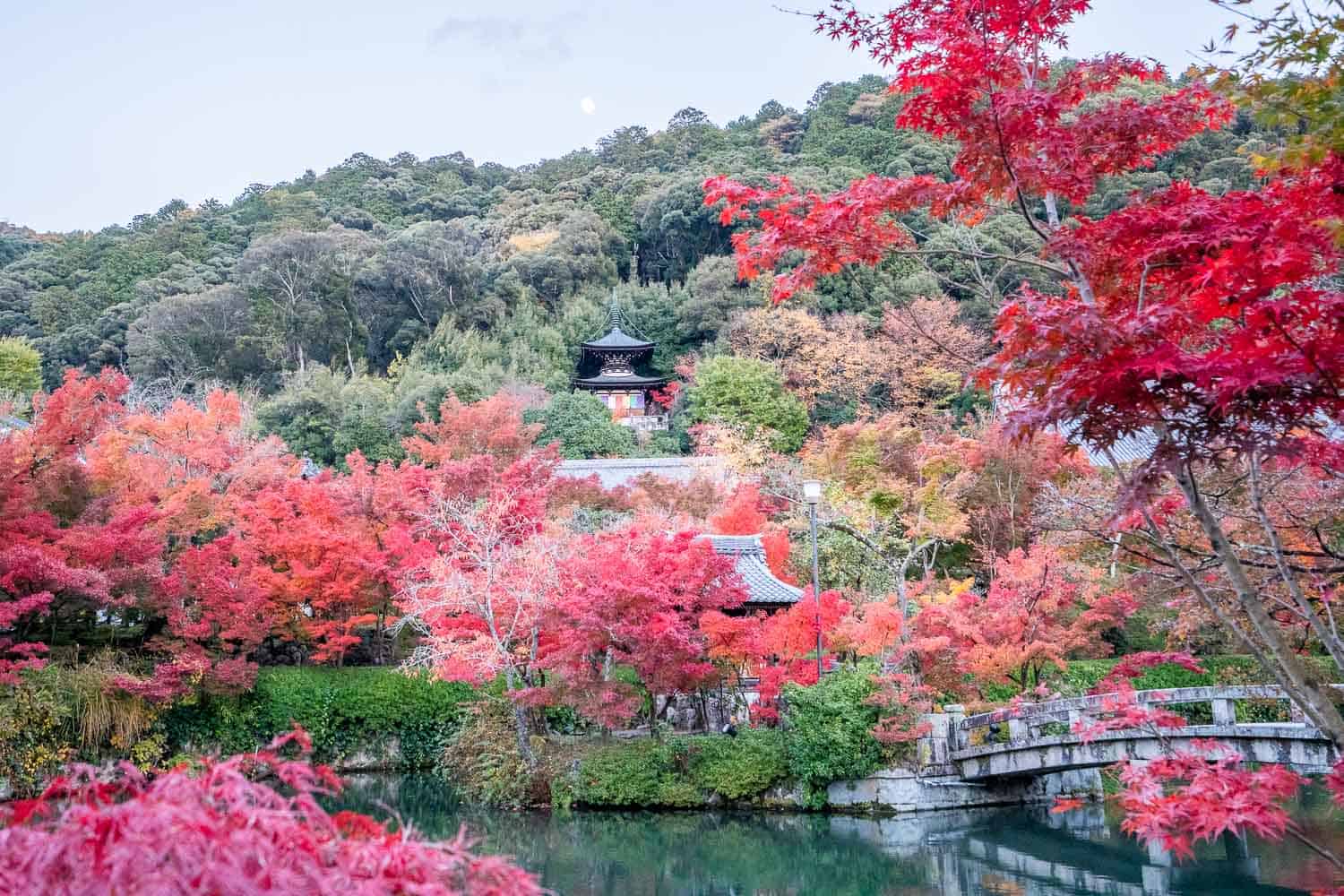
Recommended Reading: If you’re also visiting Tokyo, check out our guide to the coolest things to do in Tokyo.
Quieter Temples to Visit in Kyoto
These temples may not be as well known as the ones above, but they can often be a more enjoyable experience without the crowds.
See our guide to Kyoto temples and shrines for even more hidden gems.
10) Otagi Nenbutsu-ji Temple
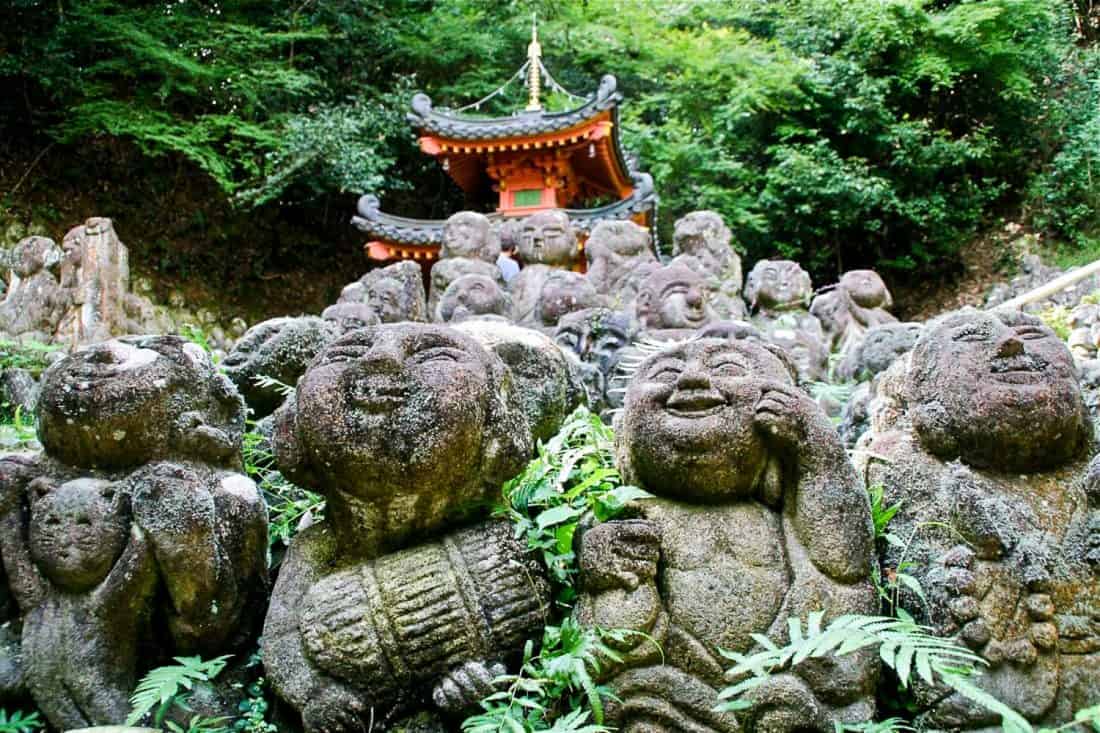
Otagi Nenbutsu-ji is a fairly long walk from the popular sights in Arashiyama, but it’s well worth it for an offbeat experience.
It’s the quirkiest temple we visited in Kyoto with 1200 stone sculptures of rakan, the Buddha’s disciples, scattered throughout a shady temple complex.
They all have different facial expressions and poses—scary, serene, cheerful, cute, and just plain bizarre.
Details: 400 yen ($3) entry fee. Open 9 am – 4.30 pm. We walked from the Saga Arashiyama station, which takes about 40 minutes uphill, and there are other temples to visit on the way. There’s also an infrequent bus or you can take a taxi from the station for about 1500 yen ($11).
11) Jojakko-ji Temple
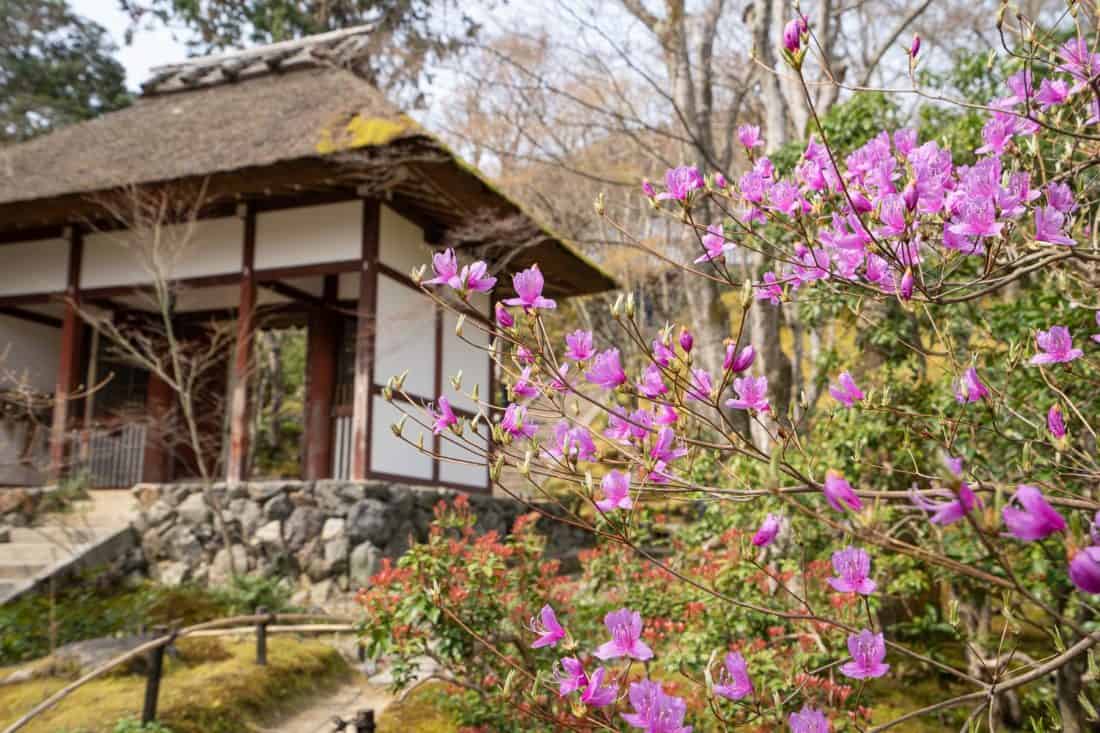
Jojakko-ji is another hidden gem in Arashiyama and one of my favourite temples in Kyoto.
The hillside gardens are extensive and feature a large cherry tree, mossy roots, small bamboo cluster, a thatched roof gate, and pagoda. There’s a fantastic view of Kyoto from the top.
It’s a beautiful temple to visit in autumn, but it’s much busier then.
Details: 500 yen ($3.50) entry fee. Open 9 am – 5 pm. It’s a 15-minute walk from Saga Arashiyama station.
12) Kodai-ji Temple
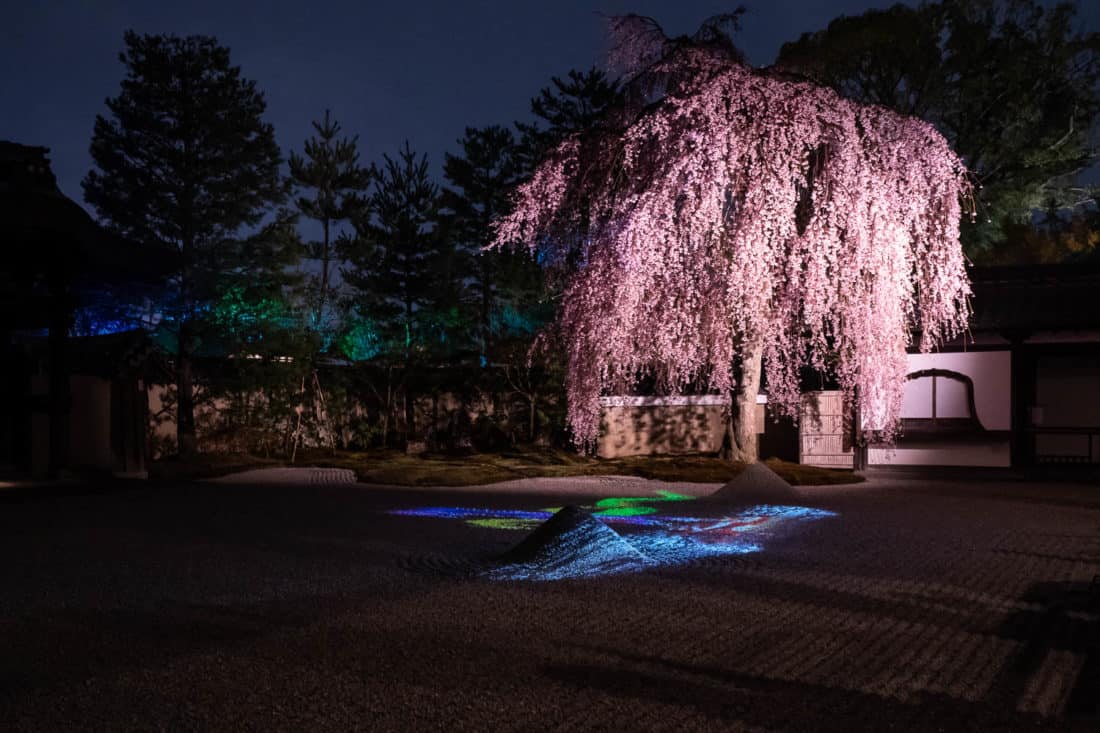
Kodai-ji isn’t quite as off-the-beaten-path as the two temples above, but we had it to ourselves when we visited at opening time.
It’s in a convenient location in Southern Higashiyama, so it’s easy to add in a visit while visiting more popular sights like Kiyomizu-dera.
The Zen Buddhist temple was established in 1606. The main hall features beautiful artwork and painted screen doors, but the gardens were the highlight for us.
The rock garden includes raked gravel and a weeping cherry tree, which is gorgeous in sakura season.
The other garden includes a pond and attractive teahouses. Make sure you walk up the hill to the bamboo grove, which is one of our favourites in Kyoto.
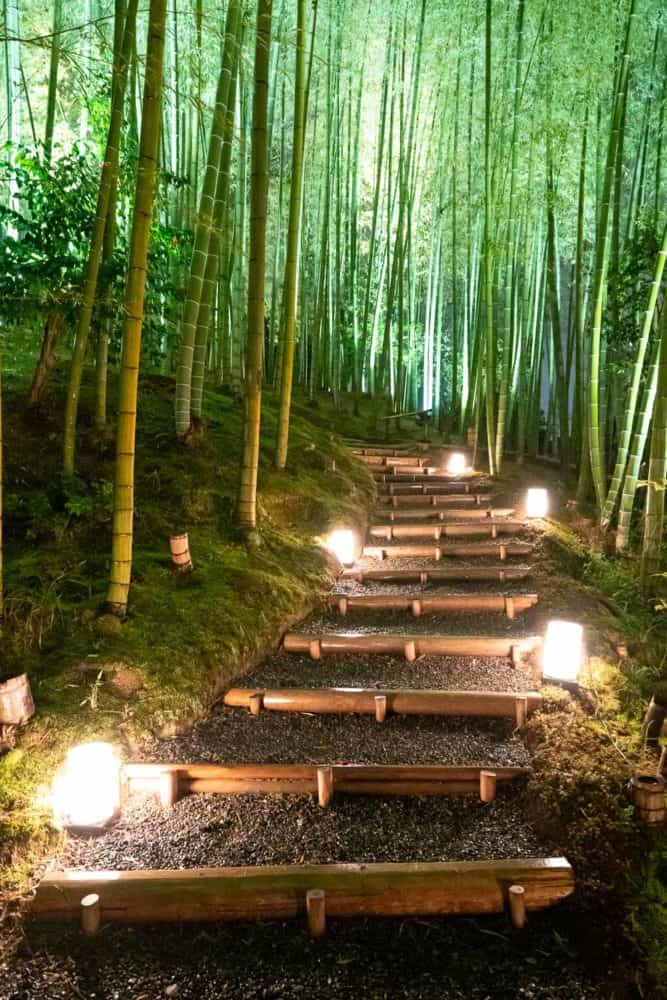
Three times a year (April, August, and November) the temple opens for special night illuminations, which are well worth visiting although it’s much more crowded.
Details: 600 yen ($4.30) entry fee (or 900 yen/$6.50 combo ticket with Entoku-in). Open 9 am – 5 pm. Best visited on a walking tour of Southern Higashiyama. It’s a 15-minute walk from Gion-Shijo station or a bus will get you closer.
13) Entoku-in Temple
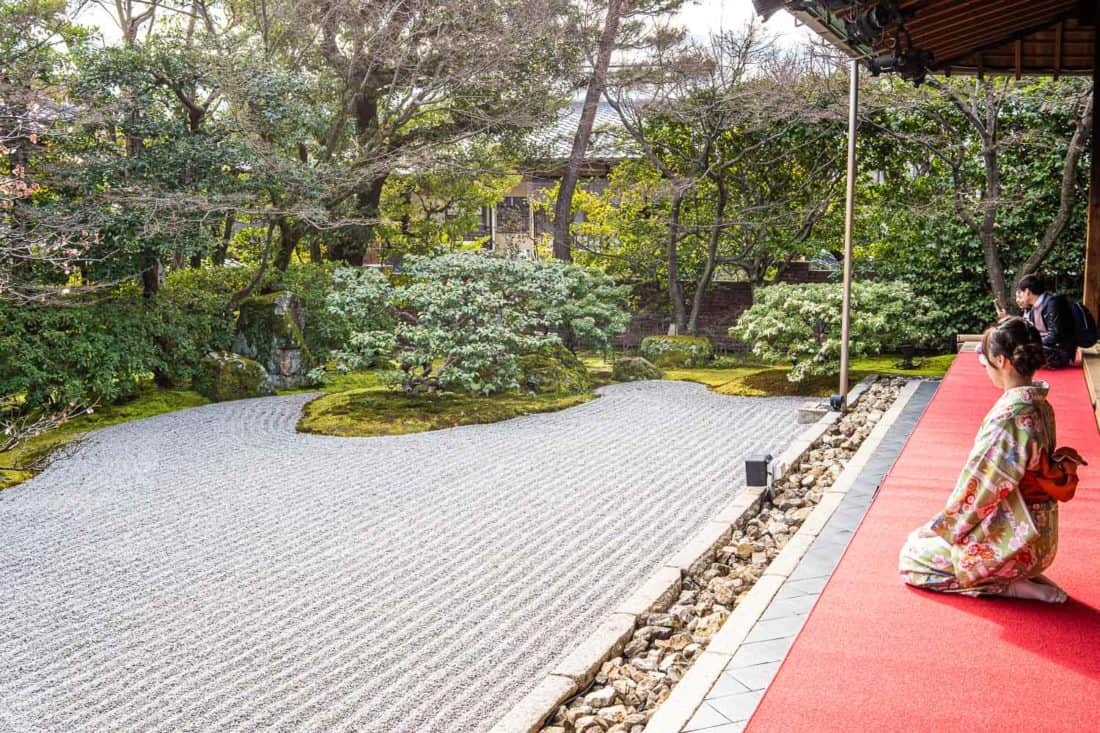
Entoku-in is a sub-temple of Kodai-ji that’s usually quiet.
There’s a small karesansui (dry stone) garden and some beautiful screen paintings, but what we most liked were the interactive elements here. You can make your own raked stone garden, trace a Buddha picture or sutra, or try zazen meditation.
You can also drink matcha (500 yen/ $3.50) overlooking a rock garden. It’s a very relaxing temple.
Details: 500 yen ($3.50) entry fee (or 900 yen/$3.50 combo ticket with Kodai-ji). Open 10 am – 5 pm. It’s a two-minute walk from Kodai-ji.
14) Kennin-ji Temple
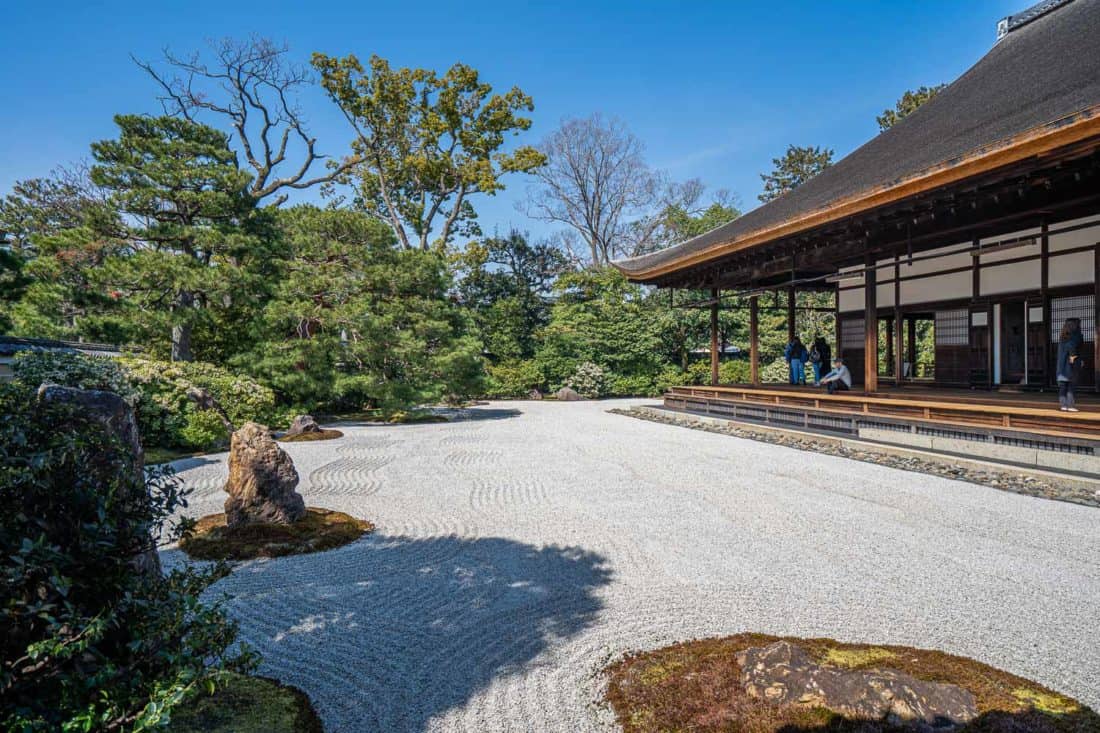
Kennin-ji is conveniently located in Gion and is close to other temples like Kodai-ji, but it doesn’t get too crowded, especially if you visit at opening.
It’s the oldest Zen temple in Kyoto and was founded in 1202. There’s a large complex where you can wander for free, but it’s worth paying to go inside.
The main building overlooks a large raked gravel garden, one of the best we visited.
There are lots of small rooms where you can admire beautiful screen paintings and you can walk in the gardens to an old teahouse.
Don’t miss the separate building where there’s a stunning ceiling painting of twin dragons, painted in 2002 to celebrate the temple’s 800th anniversary.
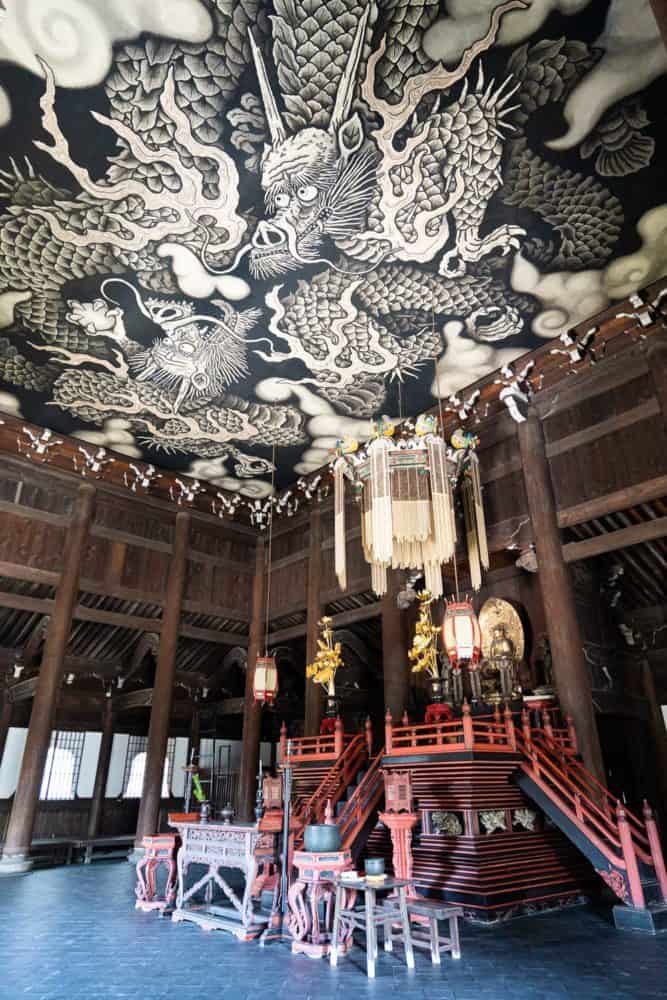
Details: 800 yen ($6) entry fee. Open 10 am – 5 pm. Gion Shijo is the nearest station.
15) Yoshida Hill Temples and Shrines
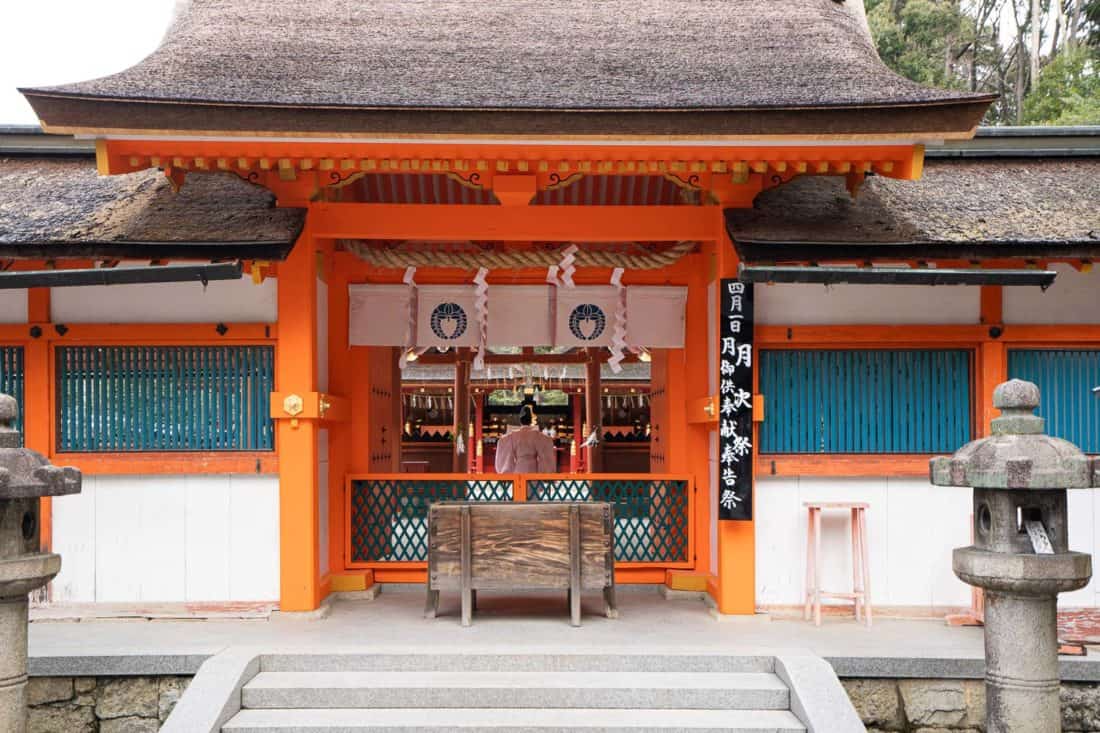
The temples and shrines on Yoshida Hill are hidden gems and are my top pick if you’re looking for non touristy things to do in Kyoto.
We couldn’t believe how empty they were, despite being just as beautiful as more well-known temples. Entrance is free and there are some good cherry blossom spots.
They are a little out of the way, but we combined them with a walk on the Philosopher’s Path—it’s a 2 km (1.2 mile) walk from the Ginkaku-ji end.
These are the four we visited with around a 5–10 minute walk between them.
- Takenaka Inari Shrine – A small shrine with a tunnel of red torii gates that is especially lovely in cherry blossom season.
- Yoshida-jinja Shrine – A peaceful forest shrine with many classic elements like torii gates and sake barrels. We saw a monk performing a ceremony here.
- Shinnyodo Temple – A large temple complex with a huge hondo (main hall) and small pond. We walked down the hill through the neighbouring graveyard to get to the next temple.
- Konkai-Komyoji Temple – Also known as Kurodani Temple, this large complex has an impressive grand entrance gate and staircase lined with cherry trees.
Details: Free entrance. Best explored on foot while in Northern Higashiyama.
Recommended Reading: If you’re looking for inspiration for the rest of your trip, see the 56 best things to do in Japan.
16) Saihoji Moss Temple
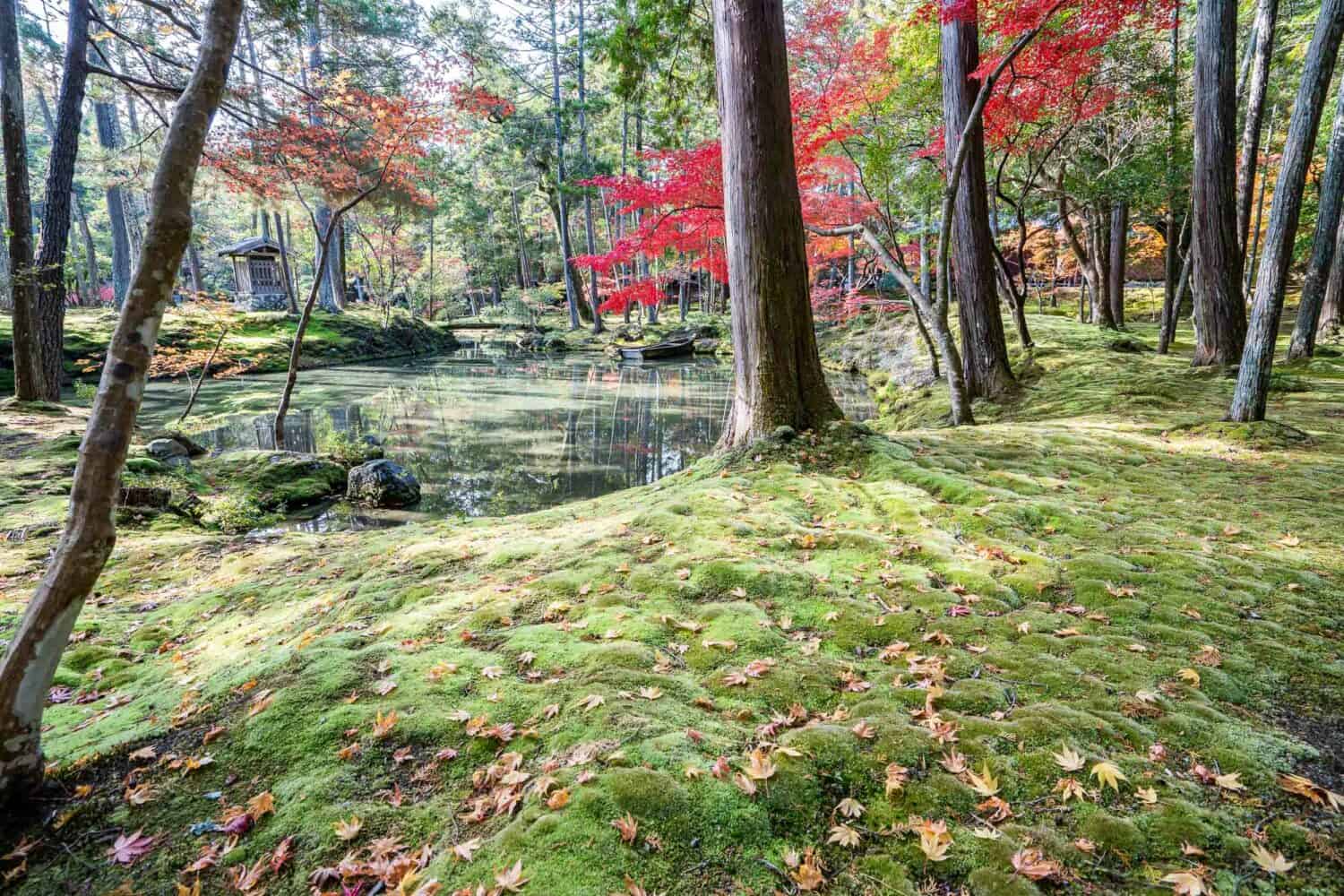
Saihoji, commonly known as the Moss Temple, is our new favourite temple in Kyoto.
It won’t be on every visitor’s must do list (it’s expensive, requires booking, and is out of the way), but it’s well worth the effort if you can fit it into your itinerary (I recommend combining it with Arashiyama).
The vibrant green mossy garden is stunning, and as visitor numbers are limited, it’s a peaceful experience (especially as you start your visit with sutra copying—easier than it sounds).
Read our guide to Saihoji Moss Temple Kyoto for everything you need to know.
Details: Entrance costs 4000 yen ($28). Bookings are essential on the Saihoji website. Opening hours vary.
Foodie Things to Do in Kyoto
17) Eat Shojin Ryori in a Temple
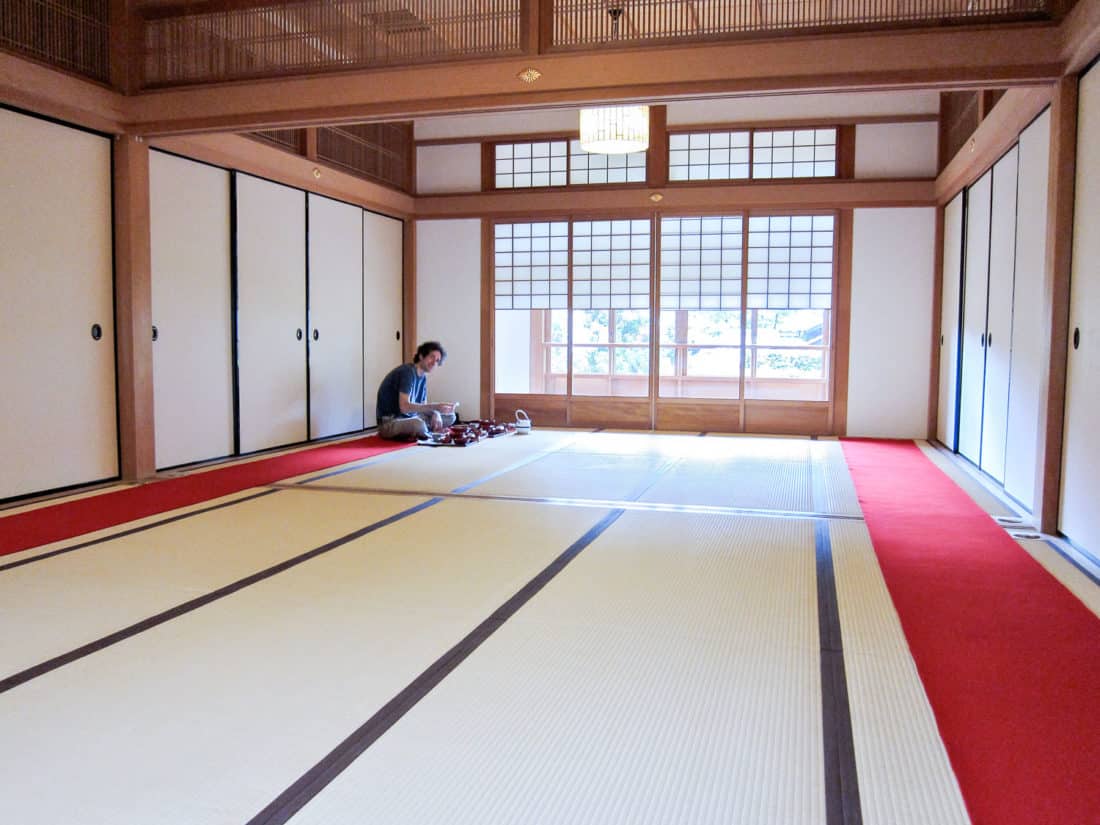
Kyoto is one of the best places in Japan for vegetarians as it’s the home of shojin ryori or Zen Buddhist temple cuisine, which is free from animal products.
Shojin ryori features multiple small dishes including tofu, seasonal vegetables, and rice. It’s healthy, balanced, and delicious, although you might find some of the unusual ingredients rather odd.
You can try shojin ryori at a number of temples including Shigetsu restaurant in Tenryu-ji in Arashiyama where you eat on the floor in a large tatami room overlooking the gardens.
See my vegetarian restaurants in Kyoto guide for more delicious places to eat.
Details: Shigetsu is open from 11 am – 2 pm (closed Thursdays) and lunch sets costs from 3800 yen ($27). You must also pay the 500 yen Tenryu-ji entrance fee. Make sure you book—ideally a month in advance or two months in peak seasons like autumn.
18) Take a Cooking Class
Japanese cuisine is fascinating and a cooking class is a great way to learn more about it beyond sushi and tempura.
We had an excellent lesson with Emi at Uzuki Kyoto Cooking Class but, unfortunately, the school has now closed.
Another option that looks good (and they can cater to vegetarians) is this Afternoon Japanese Izakaya Cooking Class with Cooking Sun where you learn to make 5-6 home-style dishes.
Other cooking classes available in Kyoto focus on different dishes such as bento boxes and ramen (with vegan option).
19) Shop at Nishiki Market
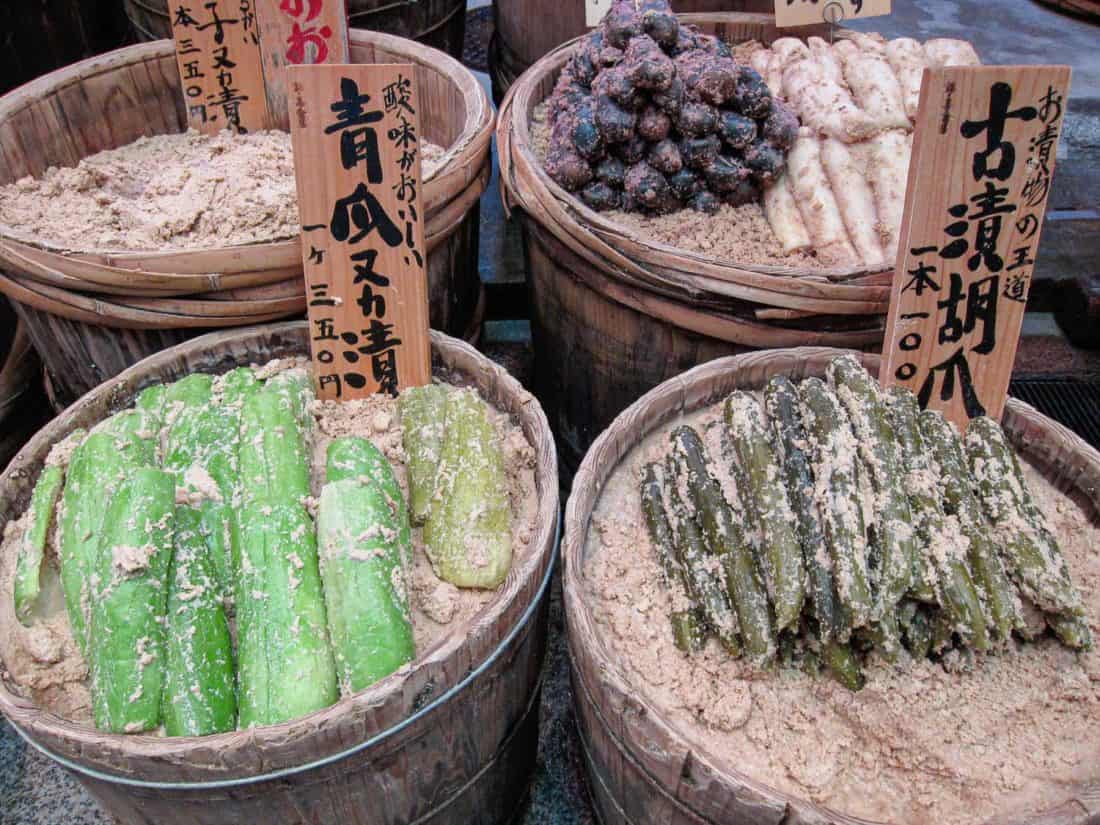
Once you’ve learnt miso from mirin on a cooking class, you can delve into Kyoto’s foodie culture some more with a visit to the Nishiki Market.
On this narrow shopping street you’ll find all the ingredients essential for Japanese cooking including an array of pickled vegetables, fish, tofu, giant miso-smothered aubergine, sweets, and other snacks.
There are plenty of opportunities to try free samples or to buy a snack to take with you. We liked the sweet black beans and the chilli coated rice cakes.
The market has become very crowded in recent years, so it’s best to visit early.
You might find it more relaxing to visit a basement food hall in a nearby department store such as Takashimaya or Daimuru instead. This is Kyoto’s main shopping area so there are plenty of options.
Nishiki Market can be overwhelming and confusing, so if you want to learn what everything is you might want to explore with a guide. Options include:
- Kyoto Nishiki Market Food Tour – Visit 10 vendors with food tastings on this 3-hour tour.
- Nishiki Market and Culture Walking Food Tour – Combine tastings at Nishiki Market with a temple visit.
- Nishiki Market Food Tour with Cooking Class – On this private tour, you shop at the market then make a donburi (rice bowl) with the ingredients you’ve chosen.
Details: Opening hours vary by stall, but it’s best to visit between 10 am to 5 pm. The nearest stations are Shijo Station on the Karasuma Subway Line or Karasuma or Kawaramachi Stations on the Hankyu Line.
20) Drink Green Tea in a Teahouse
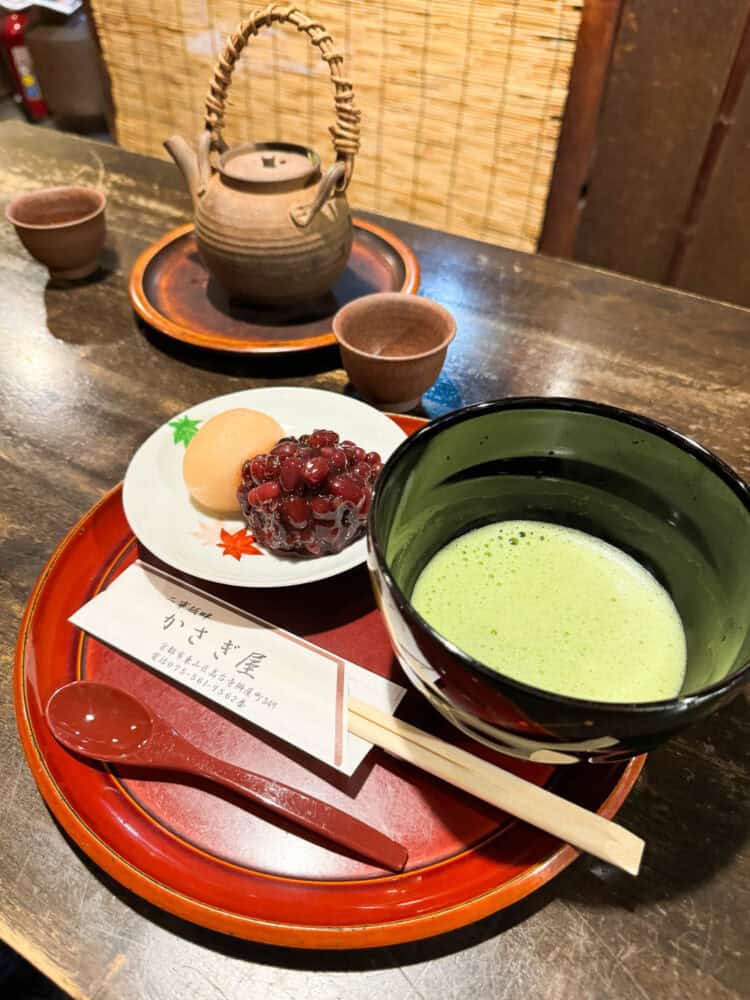
Kyoto is famous for its green tea and stopping at one of the many traditional teahouses is a Kyoto must do and the perfect break on a busy sightseeing day.
Slightly bitter, bright green matcha is served in beautiful bowls accompanied by wagashi, small Japanese sweets such as mochi made from pounded rice and sugar and stuffed with bean paste.
It can be an acquired taste, but even if you’re not a fan, it’s a great cultural experience and worth trying at least once.
There are a wide variety of other types of green tea to try too.
We loved our experience at Ippodo Tea, a highly regarded tea shop that’s been around for nearly 300 years.
This is the ideal place to buy some high-quality tea to take home as a souvenir, but you can also sample it in their tearoom.
You can choose from a range of teas and you’ll be given exact instructions (in English) on how to brew it—they take their tea very seriously here. Our tea and wagashi were superb.
Another favourite of ours for a serious tea experience is Mandaracha in Gion.
Details: The Ippodo Tearoom is open from 10 am – 5 pm. It’s a little out of the way but it’s not far south of Kyoto Imperial Palace and a 15-minute walk north of Nishiki Market.
Mandaracha is open from Friday – Tuesday (closed Weds/Thurs) from 1-6 pm on weekdays and 10 am – 6 pm on weekends. It’s easy to combine with Gion and Southern Higashiyama sights (a 15-minute walk from Kiyomizu-dera).
21) Enjoy the Perfect Pizza at Monk
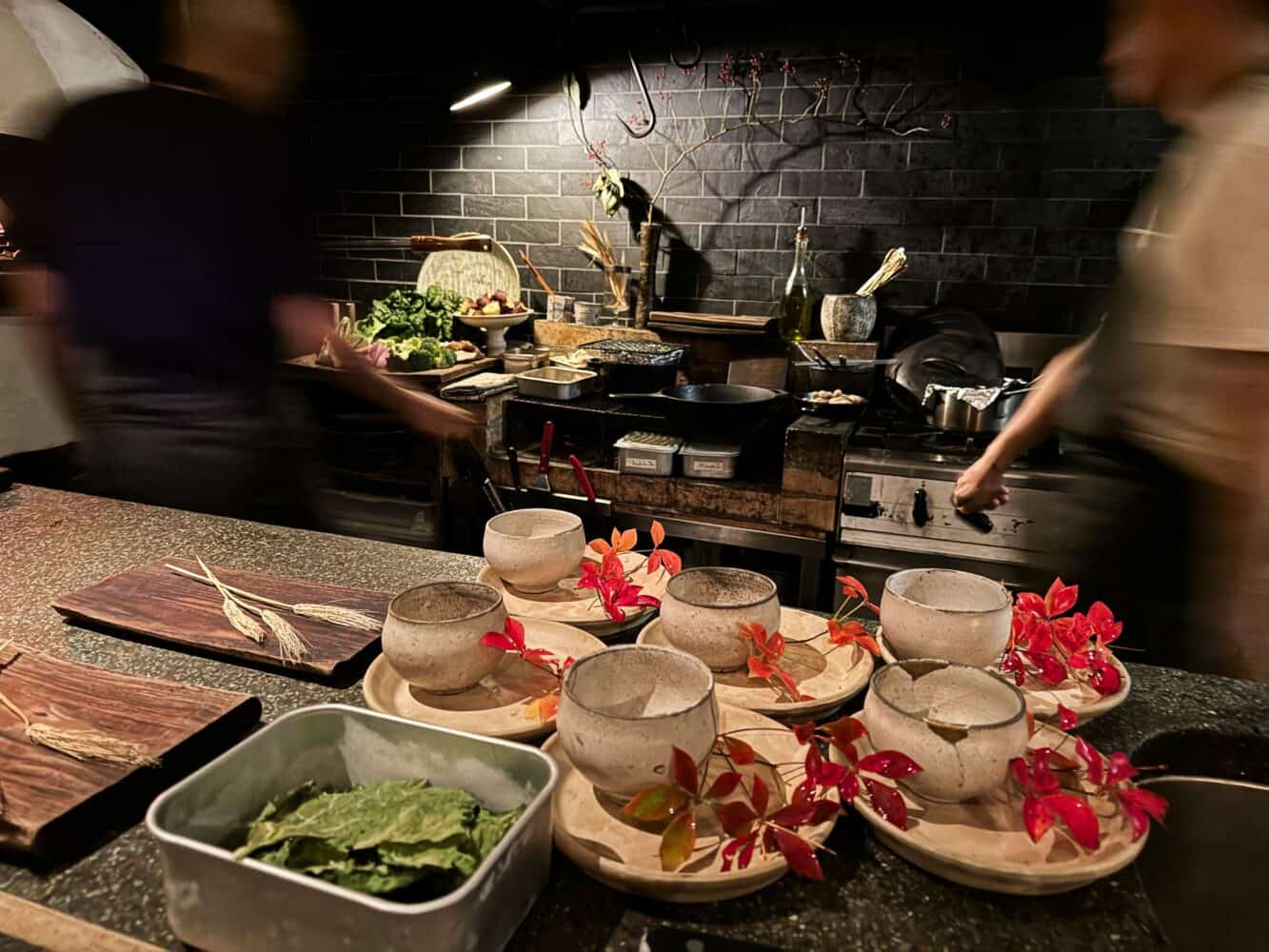
Monk is one of our favourite restaurants in Kyoto. While the menu of wood-fired roasted vegetables and pizza might not seem Japanese, this intimate restaurant has a Japanese soul.
Chef Imai prepares his eight-course tasting menus with love, using local, seasonal ingredients. Every dish is simple but perfectly cooked.
Getting a reservation at this 14-seat restaurant is challenging since it was featured on the Netflix TV show, Chef’s Table: Pizza.
Read my Monk Kyoto review for what to expect at the restaurant and step-by-step instructions on how to book.
Details: Monk is located on the Philosopher’s Path. Bookings must be made on Tablecheck exactly two months in advance. Tasting menus cost 15,400 yen ($110). They can cater to vegetarians but not vegans or gluten-free.
22) Try Liquid Cuisine at Nokishita711
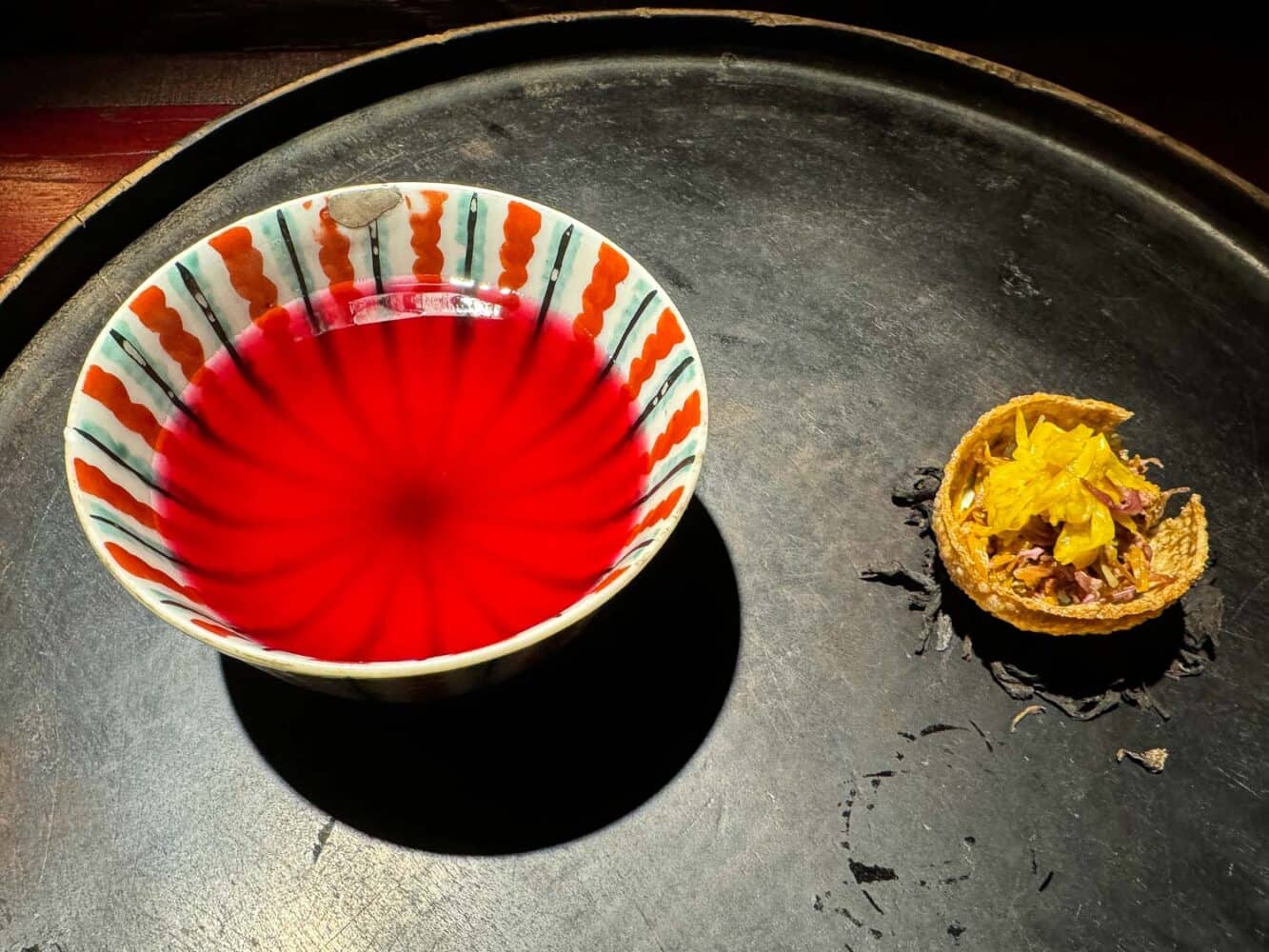
Some might describe Nokishita711 as a cocktail bar, but it’s like no bar you’ve ever been to.
Owner Tomoiki Sekine serves liquid cuisine, extracting flavours from food including meat, fish, vegetables, and fruit.
At his tiny, quirky bar, Nokishita711, there is only one table seating four people, so be prepared to be sociable.
Everyone signs up for the six-course omakase tasting menu which pairs drinks with small snacks (vegan and non-alcohol options are available).
Don’t expect sweet, fruity beverages here. Many have a fermented, kombucha-like vibe, and everything will challenge your taste buds.
As we had the vegan menu, we skipped the deer cocktail and fish ice cream. Instead, our drinks featured unusual, seasonal ingredients like incense ash, mushrooms, and artichoke roots.
The accompanying snacks were delicious, including mushroom crepes, spring rolls, and teeny tacos. It’s not enough for a meal but don’t arrive full.
The drinks are low alcohol, so even after six drinks, we didn’t feel drunk at all.
If you are want a more typical cocktail bar, consider speakeasy-style Bee’s Knees or magic-themed L’Escamoteur.
Nokishita711 is a unique culinary experience for adventurous eaters.
Details: Bookings for Nokishita711 are essential (up to two months in advance) and are easily made on Tablecheck. The tasting menu costs 8800 yen ($63) and lasts two hours. It’s located downtown.
Kyoto Activities in Nature
23) Cycle Along the Kamo River
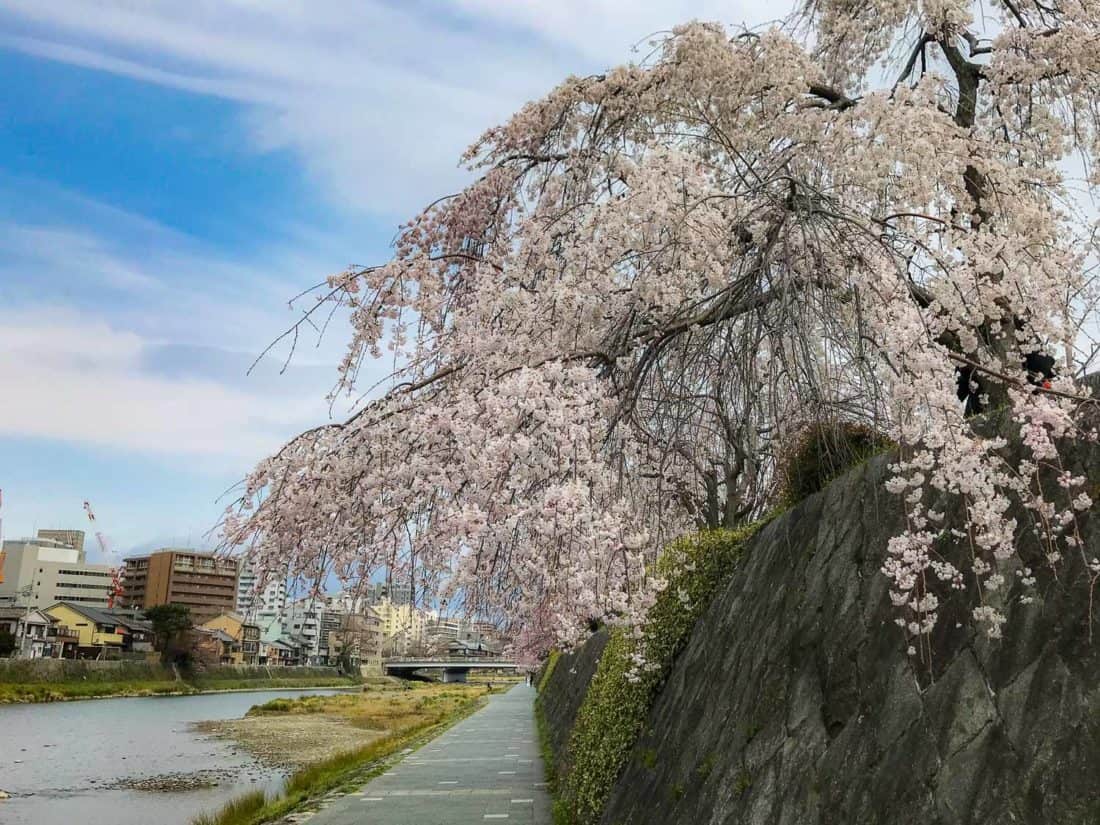
The Kamogawa or Kamo River cuts through the city and is a popular recreation spot for locals.
It’s a great place for a run, walk, or bike ride, especially in spring when the banks are lined with cherry blossoms.
On summer evenings, head to the Sanjo bridge where you’ll often find bands playing and young people hanging out and drinking—a cheaper night out than paying bar prices.
Cycling is an especially good way to explore and you can use the river path as a way of getting to northern Kyoto.
You could start in Gion and cycle north with a detour to the Imperial Palace. At the Demachiyanagi area the river forks and you’ll find the 2000-year-old shrine Shimogamo-Jinja.
Take the left fork to head to the Kyoto Botanical Gardens and the 7th-century shrine, Kamigamo-jinja.
The right fork will eventually take you to Takaraga-ike Park, an off-the-beaten-track spot that’s popular with locals for walks, picnics, and boating on the pond. I had a lovely birthday picnic here under the plum blossoms.
If you want to leave the river and cycle up Kyoto’s hills, I recommend getting an e-bike.
Details: Bicycle rental Raku-chari Nanajo is one bike rental option close to the river and a 10-minute walk from Kyoto Station.
A one-day rental from 9 am – 6 pm costs 1400 yen ($10) for a standard bike or 2400 yen ($17) for an e-bike.
24) Stroll by the Takase River
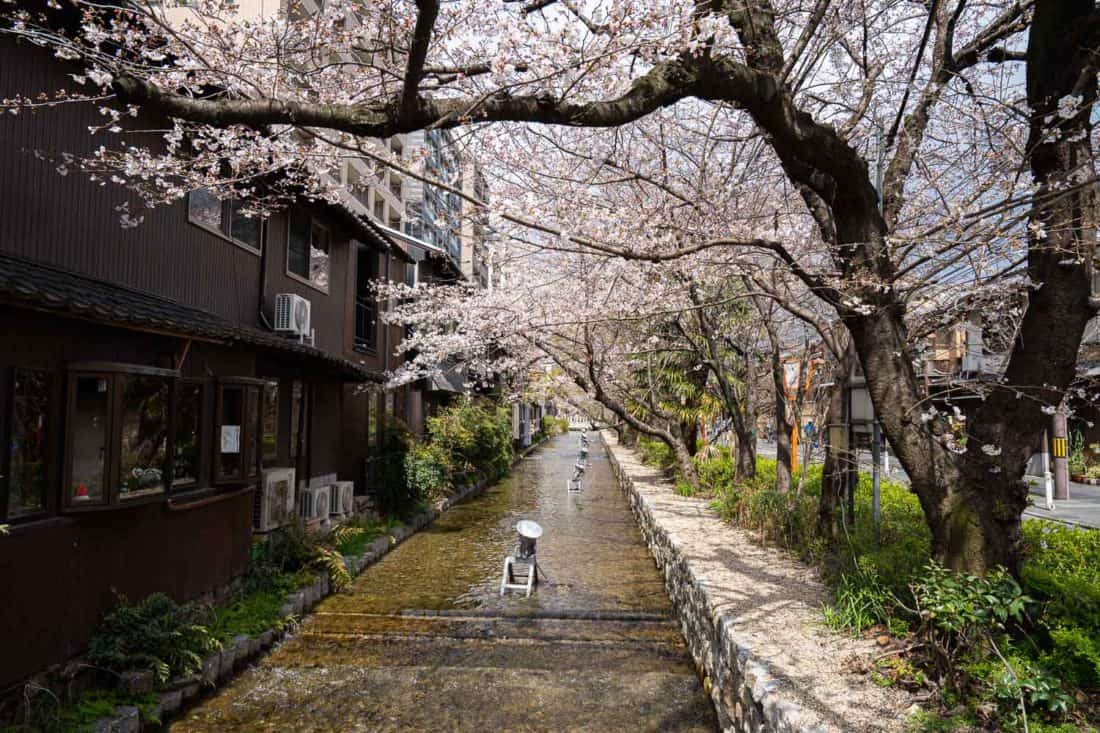
The Takase River is a narrow canal that runs next to Kiyamachi-dori parallel to the much larger Kamo River.
It was used for transporting rice and sake for over 300 years from 1611. You can see a replica of the flat-bottomed boats that were used at the starting point near Nijo-dori.
It’s an enjoyable place for a stroll by day and night, especially in spring when the cherry trees bloom, and there are lots of cafes and restaurants along the way.
The section between Sanjo-dori and Shijo-dori can be busy, especially in sakura season, but south of here it’s much quieter.
We often walked along the canal south of Gojo-dori and down past Kyoto Beer Lab and it was always a peaceful escape.
Details: Sanjo station is about a five-minute walk from the start of the canal near Nijo-dori. You could also start further south near Kawaramachi station.
25) Hike from Kibune to Kurama
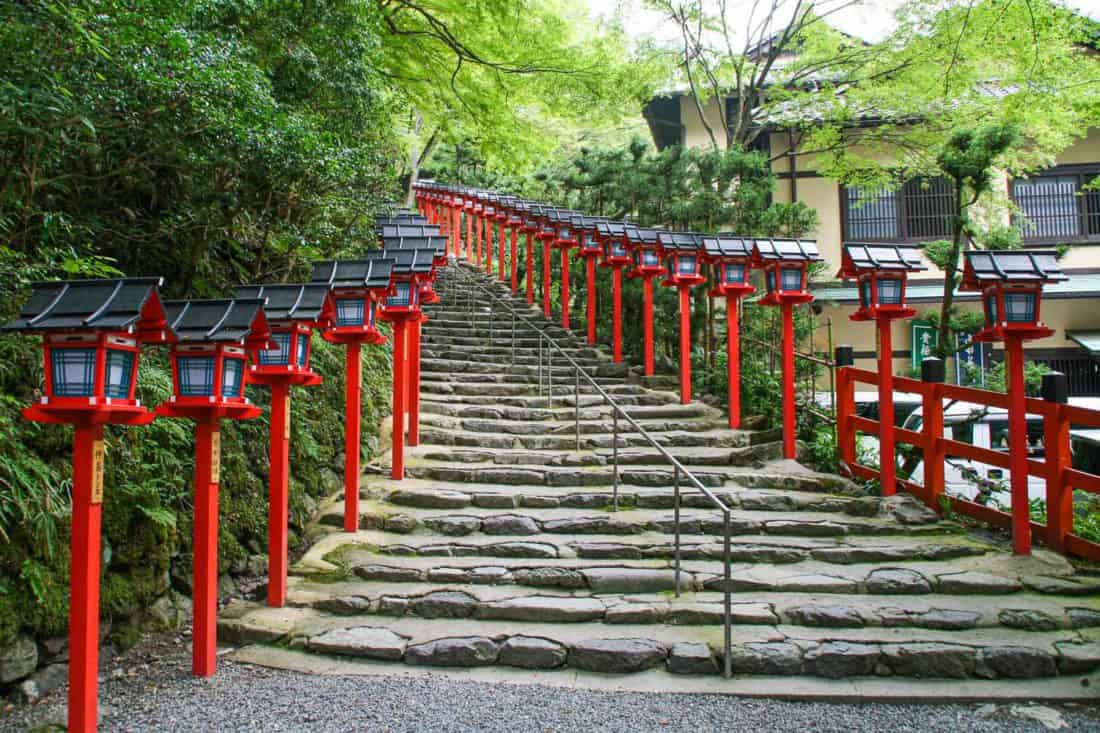
A peaceful half-day trip from Kyoto is to the villages of Kibune and Kurama in the mountains a scenic 30-minute train ride north of the city.
You can do the walk in either direction. We usually start in Kibune, visit the Kifune Shrine, then walk through the forest up a steep path up and over the mountain to Kurama-dera temple, which has fantastic views, especially in autumn.
We enjoy a tasty shojin ryori (Buddhist vegetarian) lunch at Yoshuji in Kurama before taking the train back to Kyoto.
See my guide to the best day trips from Kyoto for more information.
Details: The train on the Eizan Kurama Line from Demachi-Yanagi Station to Kibuneguchi Station takes 30 minutes. Return on the same line from Kurama Station.
Entrance to Kurama-dera is 500 yen ($3.50).
26) Discover Quieter Bamboo Groves
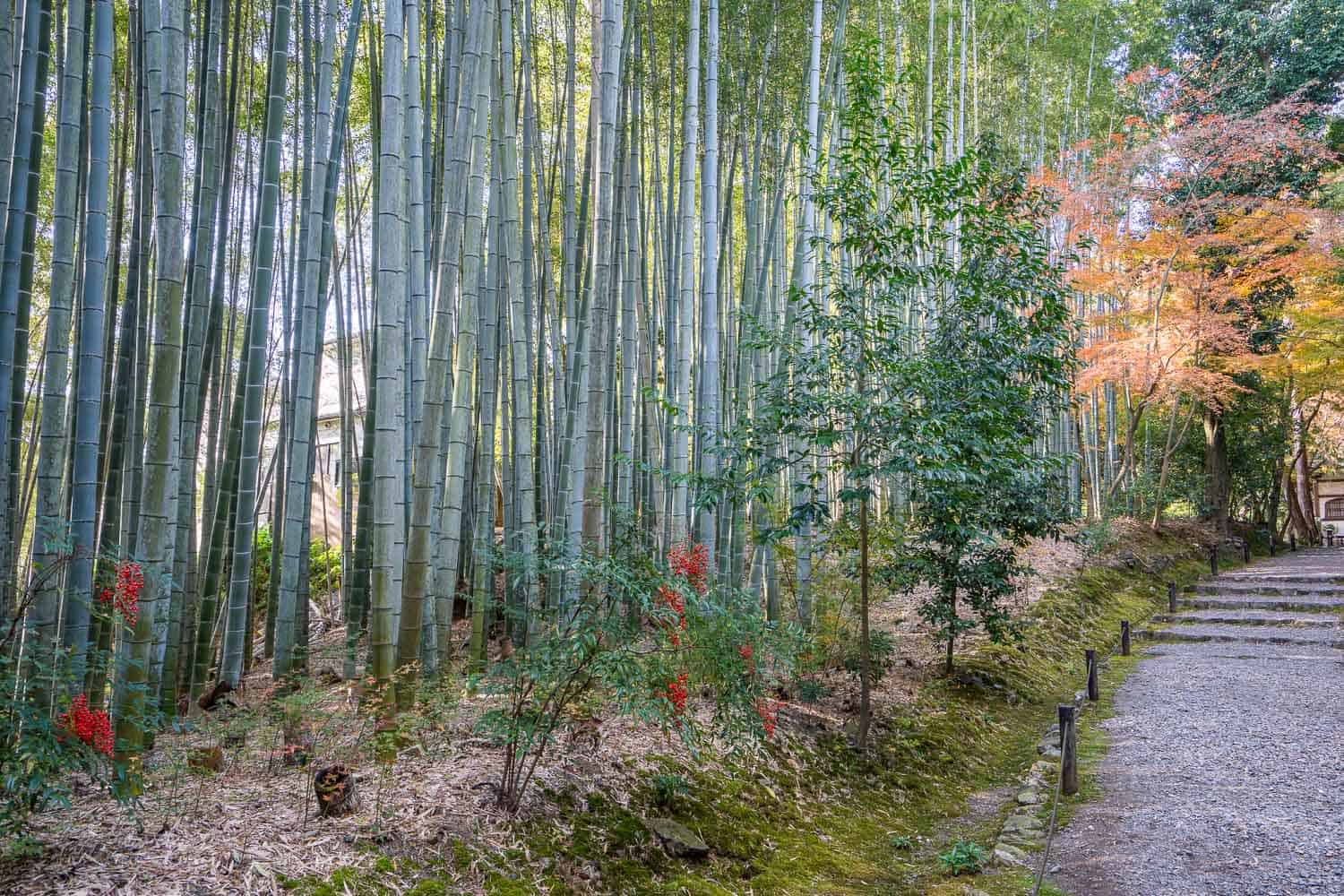
The Arashiyama Bamboo Forest is the most famous in Kyoto. While it’s worth popping by, keep your expectations low as it gets extremely crowded.
Instead, we prefer the smaller but much quieter bamboo groves at these temples:
- Jizo-in (Take-no-tera) – We accidentally discovered this on the way to Saihoji and were amazed by how quiet it was.
- Kodaiji – A lovely bamboo clump on the hillside. Beautiful at the night illuminations too.
- Jojakko-ji Temple – A good option in Arashiyama and quiet outside of autumn.
- Enkoji – Small but peaceful.
27) Wander Around Kyoto Botanical Gardens
The extensive Kyoto Botanical Gardens are a relaxing place for a walk with a wide range of trees and flowers, a turtle and carp filled pond, and a huge conservatory with plants from different climatic zones.
We visited in late summer, but it’s even lovelier with the cherry blossoms of spring or red leaves of autumn.
Details: 200 yen ($1.50) entry fee plus 200 yen for the conservatory. Main gardens open from 9 am – 5 pm and the conservatory from 10 am – 4 pm.
The nearest subway station is Kitayama Station. This is a great place to cycle to as you can get there along the Kamo River.
Cultural Things to Do in Kyoto
28) Participate in a Tea Ceremony
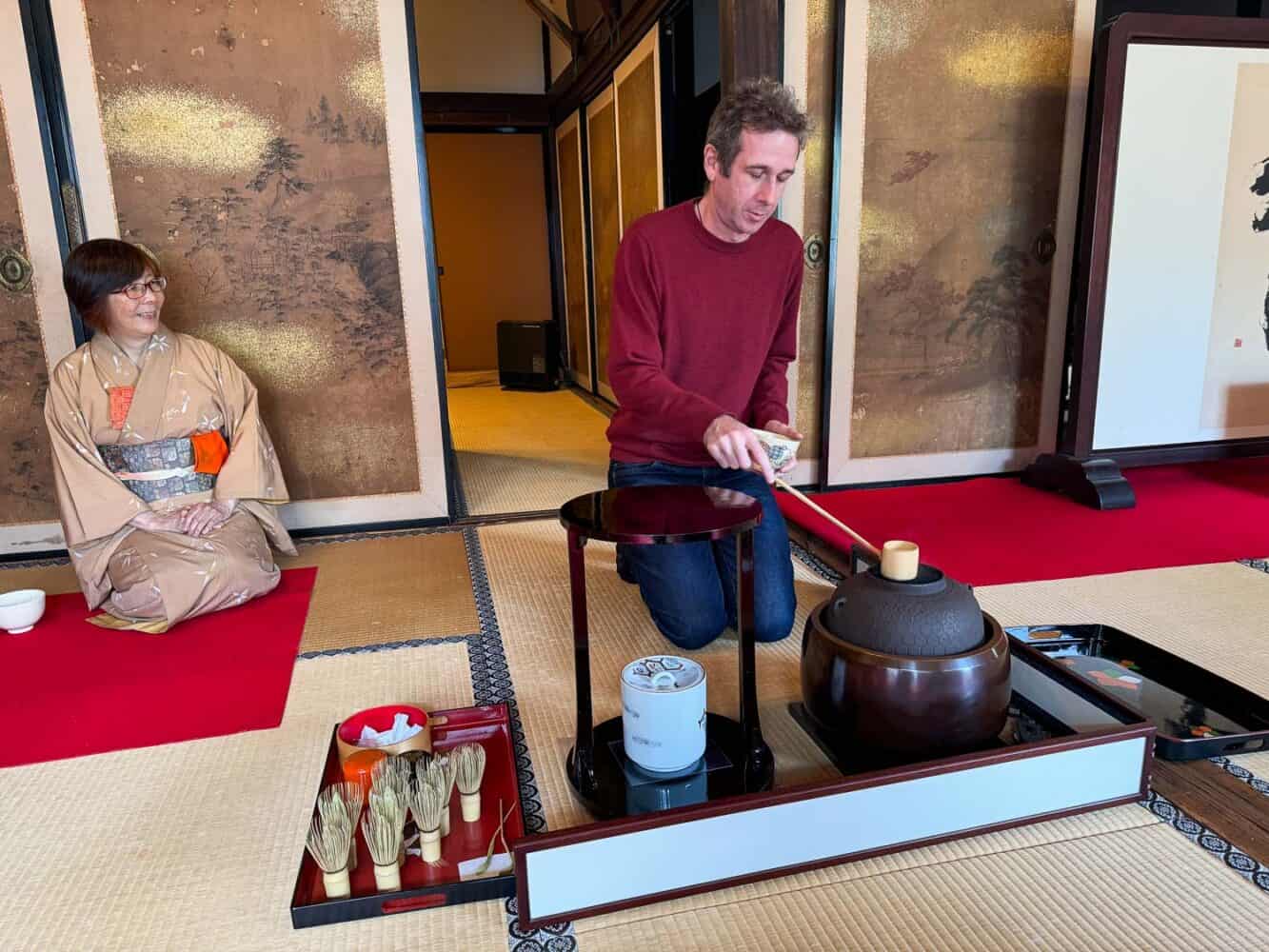
If you do just one cultural activity in Kyoto, make it a tea ceremony.
The tea ceremony ritual originated in Kyoto and is a fascinating insight into Japanese culture—it’s about so much more than just enjoying a hot drink.
The ceremony is all about being in the moment and makes a relaxing break from sightseeing.
There are many tea ceremonies in Kyoto. We did this one with Tea Ceremony Ju-An at Jotokuji Temple, which lasts about an hour with a maximum of 9 people (some groups are much larger, which I would avoid).
It’s run by two friendly women and is not at all intimidating. We learnt a lot as they took us through each stage of the ritual and enjoyed some delicious matcha we whisked ourselves.
Details: We booked Tea Ceremony Ju-An on Get Your Guide three weeks in advance (it is open weekdays only and books up). It costs 3300 yen ($24). It’s across the river from Gion, just south of downtown.
29) Watch the Geisha Spring or Autumn Dances
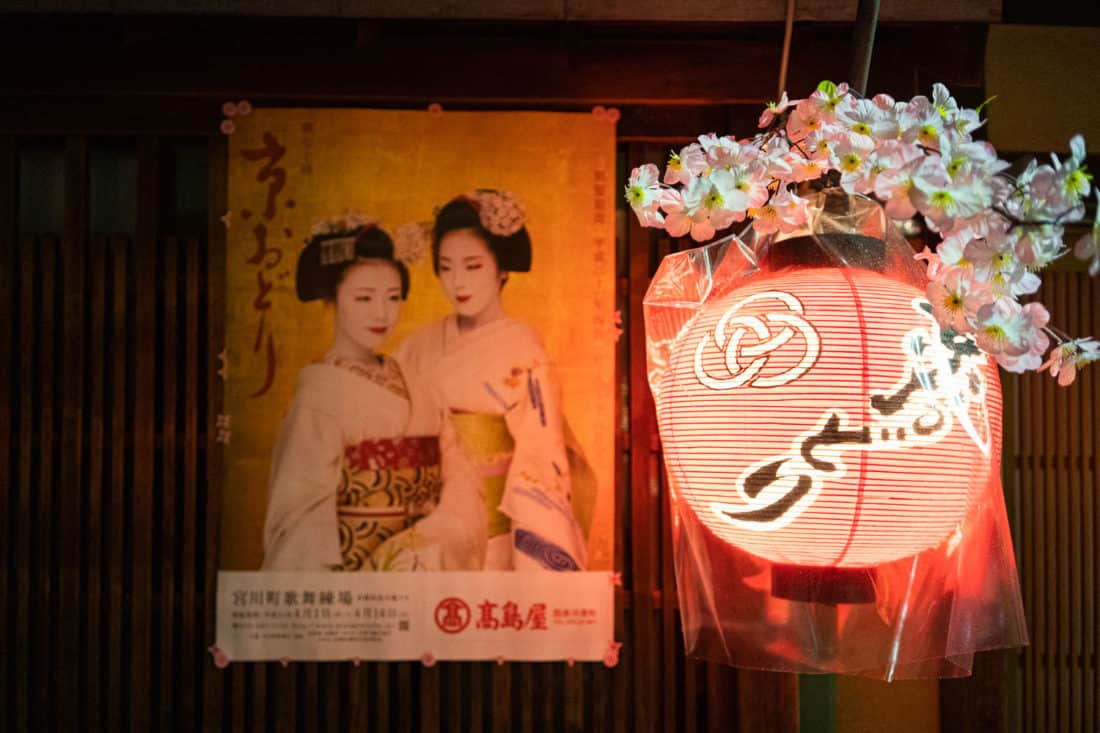
Geisha (or geiko) are one of the most fascinating aspects of Kyoto. These professional entertainers are highly skilled in traditional Japanese arts and wear elaborate outfits that belong to another time.
It’s exciting to glimpse geisha as they slip into the teahouses of Gion, but it’s even better if you can watch them perform.
Every year in April and November, the geisha districts put on spectacular dances where you can see dozens of geiko and maiko (apprentice geisha) dancing, acting, singing, and playing traditional instruments.
They are stunning shows and I loved getting a closer look at those extravagant kimono and hairstyles.
Don’t miss a show if you’re visiting when they are on—it’s one of the best things to see in Kyoto.
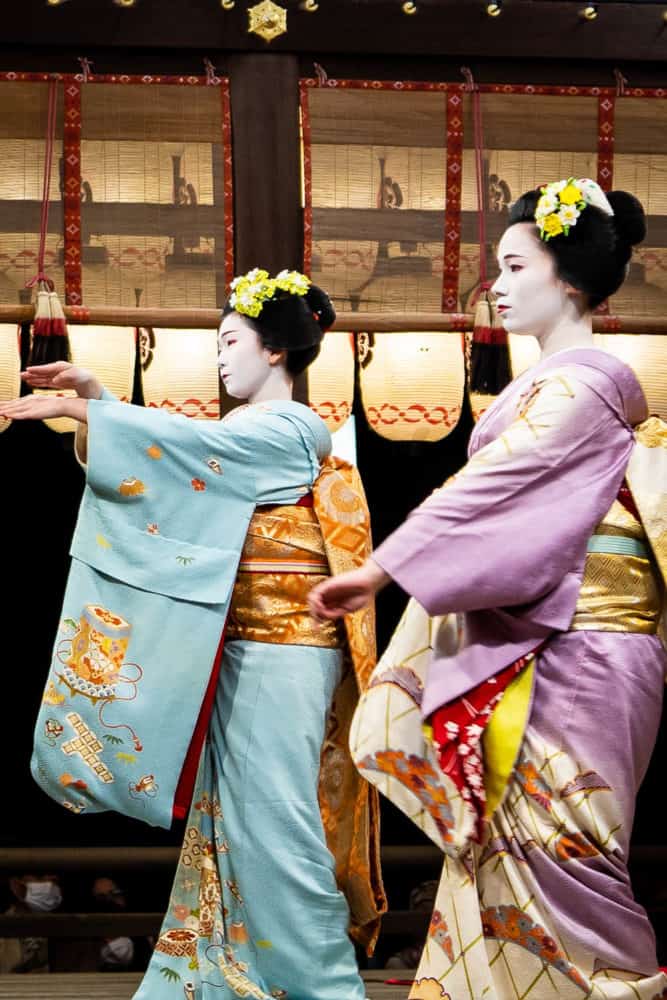
In April, the Miyako Odori in Gion is the most famous, but we went to the nearby Kyo Odori in our neighbourhood Miyagawacho instead where there were very few tourists. See my Kyoto cherry blossom guide for more details.
In autumn, the Gion Odori is held from 1 – 10 November and we found it just as beautiful (if busier with tourists). We bought tickets a few days in advance from the Gion Kaikan Hall where it is held (online ticket sales don’t work with foreign cards).
30) Geek Out at Kyoto International Manga Museum
If you are interested in manga (comics) culture, the Kyoto International Manga Museum is the ideal rainy day destination.
There’s a small exhibition looking at the role manga has played in Japanese culture, but mostly there are just lots and lots of manga comics and graphic novels.
The collection houses 300,000 volumes, and although they are mostly in Japanese, they have translations into many other languages, too.
Throughout the museum you’ll find towering bookshelves and geeky kids quietly reading.
Details: Entrance to Kyoto Manga Museum is 1200 yen ($8.50). Open 10 am – 5 pm (closed Wednesdays). Karasuma-Oike is the nearest subway station.
31) Learn a Traditional Japanese Skill
As the home of traditional Japanese culture, there are many opportunities in Kyoto to learn more about the arts and try a unique activity.
We’re adding these fun things to do in Kyoto to our list for our next visit:
- Samurai Experience – Wield a real katana (Japanese sword) and learn about Zen and bushido (the moral code of samurai) in a 250-year-old samurai residence.
- Itajime Shibori Scarf Class – Learn the oldest dyeing method in Japan and take home a scarf you’ve made.
- Ninja Training Dojo – Learn ninja skills including how to use ninja weapons.
- Calligraphy Workshop – Make your own silkscreen-printed kanji t-shirt in this private calligraphy workshop.
Kyoto Attractions Map
This Kyoto sightseeing map shows the best things to do in Kyoto. Temples and shrines are marked in red, interesting streets and walking paths in blue, other points of interest in purple, and recommended hotels in yellow.
How to Get to Kyoto
Kyoto is best reached by train.
If you fly into Kansai International Airport (KIX), the Airport Express Haruka train to Kyoto takes 1 hour 20 minutes.
If you fly into Tokyo, you can take the shinkansen (bullet train) to Kyoto in 2 hours 15 minutes on the fastest train.
If you’ll be travelling around Japan, it’s worth considering a Japan Rail Pass. Read my post on whether a Japan Rail Pass is worth it for more details.
The Japan Travel by Navitime website or app is the best way to check train times and prices.
Getting Around Kyoto
We love to walk as much as possible in Kyoto as we often discover hidden spots along the way.
Cycling is also great along the Kamo River, but I wouldn’t venture up to the main sightseeing areas of Higashiyama or Arashiyama as they’re too hilly and crowded.
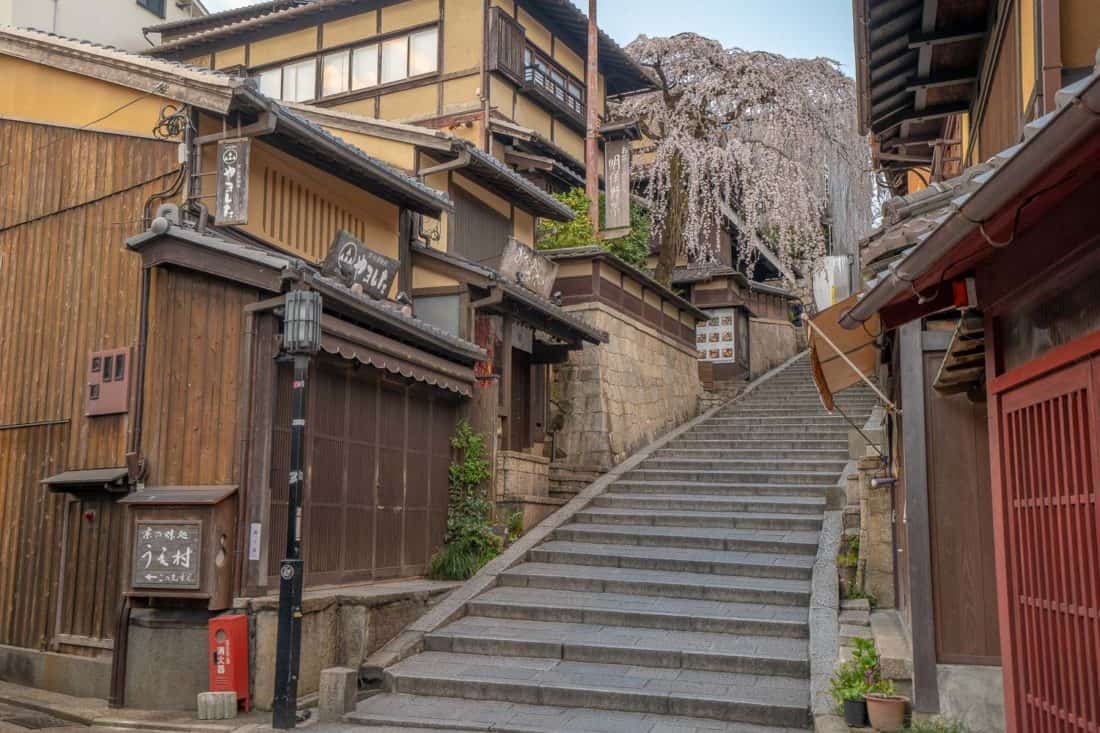
The public transport system isn’t brilliant and you’ll need to take a mix of trains, subway, and buses to get to every part of the city. A prepaid ICOCA or Suica card can be used on all of them.
We use Google Maps for public transport routes and directions.
Life will be much easier if you have a data plan on your phone—a Japan e-SIM by Airalo is the easiest way to get affordable data. You can set it up before you arrive and it doesn’t require a physical SIM card (so you can keep your home SIM in your phone).
Taxis can be convenient for out of the way locations and are much faster than the buses (which can also be crowded). I recommend taking a taxi when you arrive with luggage. Red lights mean the taxi is available.
Drivers don’t usually speak English, so it’s best to have your destination written down in Japanese (or show the Google Maps listing) unless it’s a well-known sight.
You can also use Uber in Kyoto. It’s easier as you don’t have to explain your destination, but it costs more than hailing a taxi from the street and the wait can be longer.
At Kyoto Station, there’s a foreigner-friendly taxi stand (the drivers speak English and accept credit cards), but we found the waits here long, so it’s best to join the regular queue.
Video: What to Do in Kyoto
Watch our video for an overview of what to see in Kyoto, Japan.
Is Kyoto Worth Visiting?
Yes, Kyoto is absolutely worth visiting! It should be top of your list of places to visit in Japan.
It’s a wonderful mix of traditional culture, stunning temples, beautiful gardens, delicious food, and interesting activities.
I hope the ideas in this post will help you love Kyoto as much as we do! There can be an overwhelming amount to do in the city, but don’t try to see it all.
Choose a few activities from each of the sections above and you’ll have an amazing Kyoto trip that includes some classic spots as well as more peaceful sights off the beaten track.
More Japan Posts
Read more of our Kyoto and Japan travel tips.
Kyoto
- Where to Stay in Kyoto: Recommended Hotels and Areas
- 14 Stunning Places to See the Cherry Blossoms in Kyoto
- Kyoto in Autumn: 10 Stunning Fall Foliage Spots
- 20 Best Vegetarian Restaurants in Kyoto
- The Ultimate Guide to Kyoto Temples and Shrines
- 14 Best Day Trips from Kyoto
- Visiting Saihoji, the Stunning Kyoto Moss Temple
- Monk Kyoto Review and How to Get a Reservation
General Japan Tips
- Planning a Trip to Japan: Dos and Don’ts
- 16 Unmissable Places to Visit in Japan
- Two Weeks in Japan: A Detailed Itinerary
- 56 Best Things to Do in Japan for an Unforgettable Trip
Enjoyed this post? Pin for later!
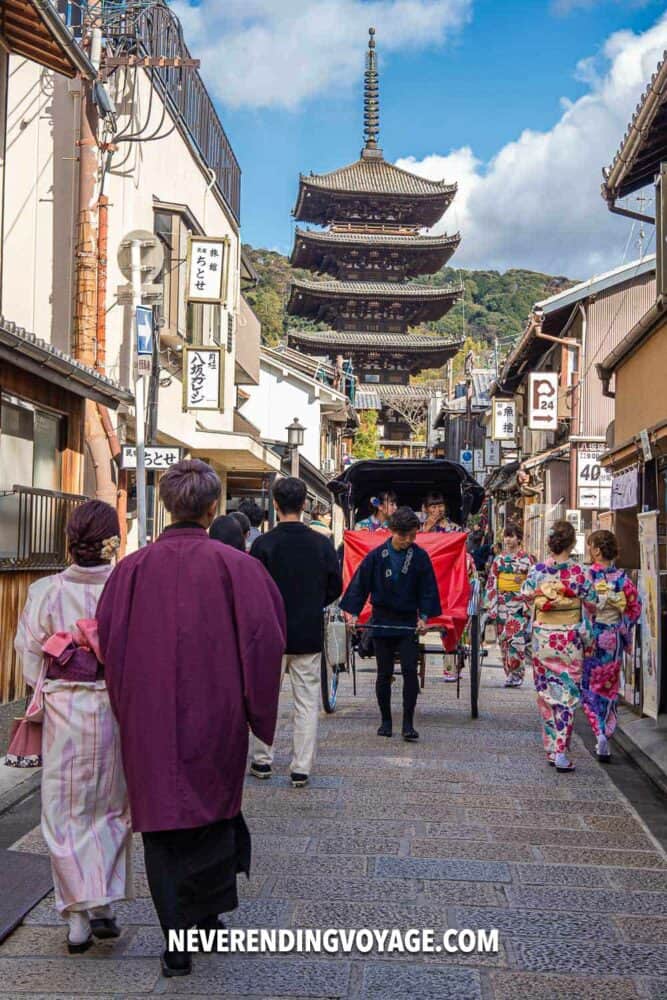
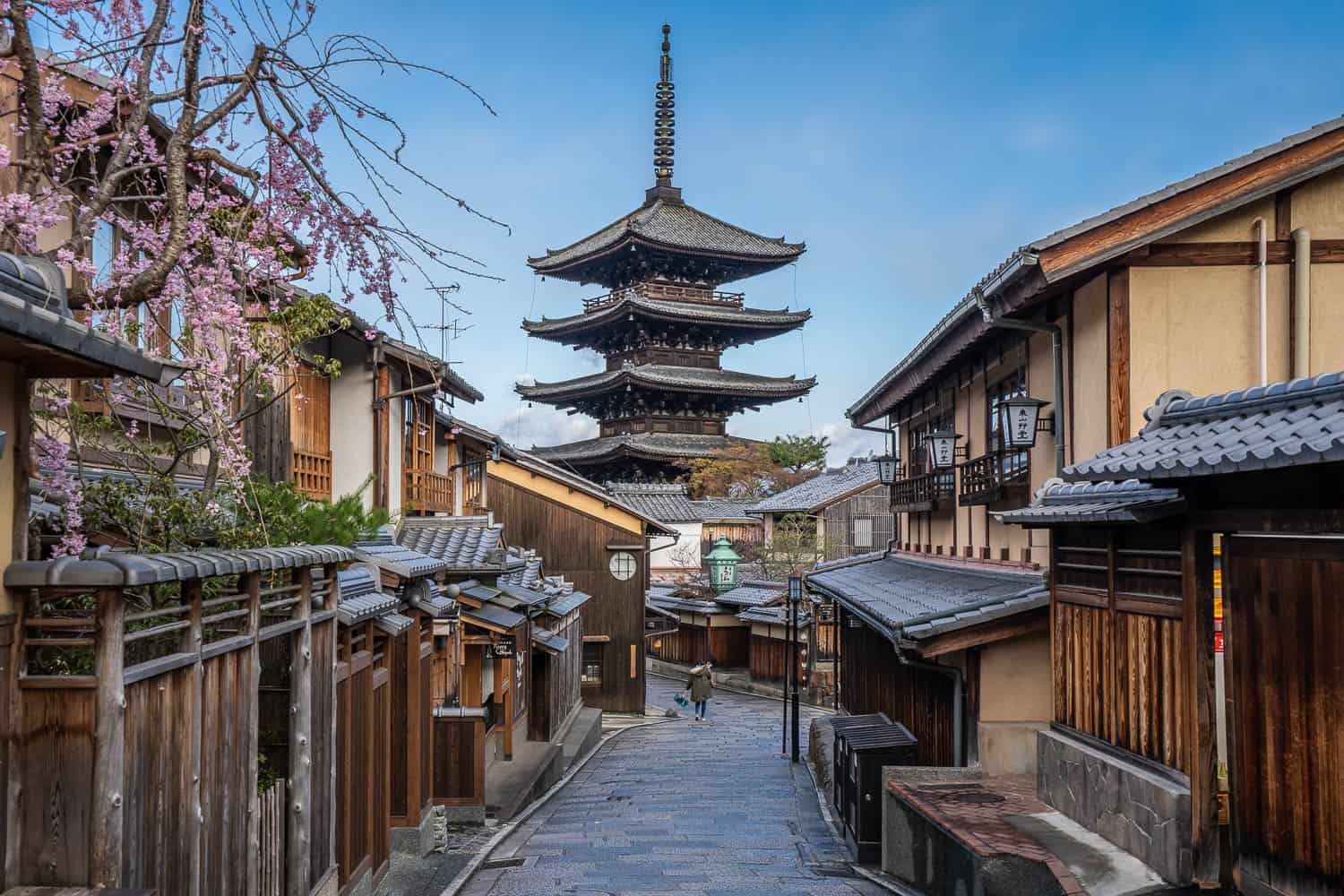
Love your write up.. Very very informative…
We(couple) along with 2 year old baby are travelling to Japan in Nov 2024 for 15 days— we planning 6 days Tokyo(1 daytrip to Hakone, 1 daytrip Kamakura) —- 4 days Kyoto(1daytrip Nara )–2 days Osaka(1 day tripto Hiroshima & Miyajima)- again 2 days in Tokyo.
1) IS our itinerary good or we can include more?
2) Should we do Mount Fuji separately, even if doing Hakone?
3) Should we do Takayama for 2 days?
4) Any onsen you suggest for us to stay if we don detour from our initial plan?
5) Where(location) do u suggest staying in Ryokan as per our itinerary?
Where would you recommend staying in Kyoto?
If you want to be close to the oldest streets and temples, Gion is great. We liked Hotel The Celestine on a quiet street there or we often get an Airbnb.
Or to be closer to shopping and slightly better transport links, you could look at downtown (a more modern area). We liked Sora Niwa Terrace for the amazing view from its onsen and rooftop bar. The rooms are really nice (it’s quite new) but small.
Thank you for the details of your trip. If I may ask, is there a place you can recommend where to rent kimono’s?
I don’t have any personal experience, but if you want to book online and pick up downtown (near the Ju An Tea Ceremony that we enjoyed) there’s Kyoto Kimono Rental Yumeyakata.
Or there are loads of shops (no booking needed) in Gion (near Yasaka Pagoda) such as Rental Kimono Rose.
THANK YOU SO MUCH FOR THIS AMAZING GUIDE
IT IS VERY HELPFUL
Wow! Thank you so much for this wonderful guide! It’s so beautifully written, and the attention to detail is much appreciated. I don’t have to look any further for my Kyoto plan.
Thank you Bharath and enjoy Kyoto!
Thank you for such a brilliant detailed post. I’ve been to Kyoto a few times and am here again currently! I was looking for other things to do aside from the usual recommendations and this post has given me lots of ideas :)
It’s been many years since I’ve visited Japan and though I went 4 times (with another one on the way!) there’s still more to explore. Thanks for the pointers (and reminders) for some good places to spend time. The photos are beautiful and the links are so helpful. Thank you so much for putting this together (and I completely agree re Arashiyama).
First Japan guide I’ve seen that mentioned eSim. I HAD NO IDEA about these. Thank you very much.
Definitely easier than the pocket wifis that everyone recommends!
Thank you. This gives so much information :-)
Amazing guide! Thank you for putting something so comprehensive together. Looking forward to using your list when we visit this weekend.
Enjoy Kyoto, Randy!
Thank you for putting so much time and energy into creating this excellent resource!
Aw, thank you Ryan! We love Kyoto and are lucky to have had so much time there.
Thank you for providing this information on places to visit. I plan to return to Kyoto once we are able to travel again. I loved it!! It is an amazing place to visit.
I am taking my Mom to Japan, I must confess, when ran across ur site, I must say, it was my 1st and last sop during my trip research process. your attention to detail and useful information is overwhelming, Thank you so much. I am a fan.
Thank you so much, Carlos! I’m glad you found it useful and hope you don’t have to wait too long to visit Japan.
Ugh it’s on my bucket list to visit Japan during cherry blossom season! Maybe next year!
Your article is brilliant, so informative. I’m planning a trip to Japan next summer and I’m torn between an extra day in Kyoto or a day trip to Nikko (when in Tokyo). What would you recommend? We would have 2 and a half days in Kyoto if we kept in the Nikko day trip but I’m starting to think I would prefer the extra day in Kyoto. Thank you.
I would probably go for an extra day in Kyoto – there’s just so much to do there. Enjoy!
If staying for a week in Kyoto, would you recommend hiring a car, or is driving too stressful?!
I think driving would be too stressful and it’s so easy to get around by train, it’s not really worth it. We spent a month in Kyoto and never felt the need for a car.
We went some time ago and I found by chance the railway museum there. Very interesting collection of equipment. Within walking distance of the regular railway station. The locomotives seemed to be a mixture of US and European designs.
We’ll have to check that out next time, thank you!
Excelent tips, will make my trip to Japan much enjoyaBle. Thanks a lo, will continúe to check the other articles
WOW, Kyoto is just beautiful, I will love so much to go and know this place!! The scenes are very beautiful, the great landscapes that you have in your pictures are amazing! I will love to go and take a lot of pictures!
Great pics. We spent 4 weeks in Kyoto a few years back and saw most of these temples. I like what you say about the tourists and how to avoid them…we were surprised by just how many tourists there were (all fighting to take photos…but politely because they’re Japanese :) ). And also about the local transport which, surprisingly, is not very good. Many of the temples on the foothills of the city and some only accessible by city bus which sometimes made for some long journeys.
We also did the Ninja training. Lots of fun, would recommend.
I would also mention a visit to the train station (Kyoto Station). Incredible building and some great views over the city.
And you’re very right about the Kamo river. Nice place for a walk or a jog and best of all free. We spent a lot of time walking it.
Frank (bbqboy)
Yes, Kyoto Station is lovely! Glad you enjoyed your stay as much as we did!